Paul van Yperen's Blog, page 230
June 27, 2019
A Neapolitan at Cinecittà, Eduardo De Filippo the Filmmaker
We're in Bologna, Italy, and like every year, EFSP follows Cinema Ritrovato! This festival we like to discover the genius of Neapolitan actor-director Eduardo De Filippo (1900-1985) as filmmaker in Cinecittà. This towering, multifaceted figure of Italian culture was best known for his plays Filumena Marturano and Napoli Milionaria. He began to direct films in 1940. During the 1950s, he turned out a string of successful light comedies, many based on his own plays. In addition to writing and directing his own films, he also wrote or collaborated on films with such directors as Vittorio De Sica.
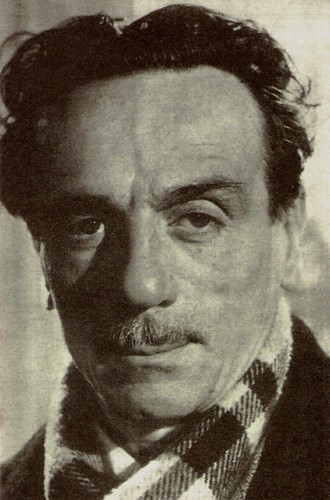
Italian postcard.
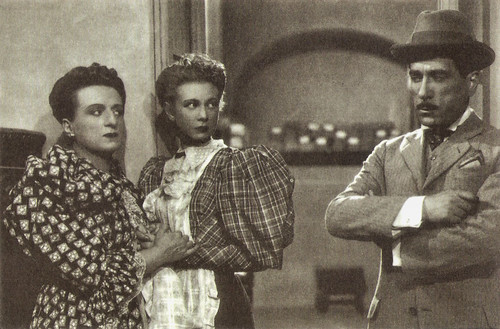
Italian postcard. Film scene with at left Titina de Filippo and right Eduardo De Filippo. In between them an unknown actress.
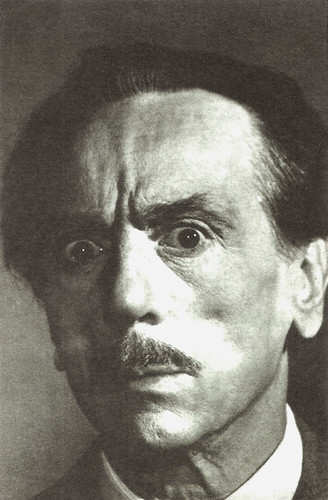
Italian postcard.
I do not pay you!
Eduardo De Filippo was born in Naples, Italy in 1900. He was the illegitimate son of actor/playwright Eduardo Scarpetta and theatre seamstress/costumer Luisa De Filippo. His sister was actress Titina De Filippo and his brother was actor/writer Peppino De Filippo .
Eduardo began acting at the age of four or five, the sources differ. According to Italica , the website of Rai International, he made his debut in 1904 as a Japanese child in La geisha (The Geisha), written by his father. The next year, he was Peppiniello in his father's comedy Miseria e nobiltà (Poverty and Nobility).
In 1914 he joined the regular staff of his step-brother Eduardo Scarpetta's theatre company, where he stayed until 1920 when he was called up for military service. In 1922, on completing his military service, he resumed his acting career in the theatre.
Like his father, he also started to write for the stage. Among his early plays are Farmacia di turno (The All-night Chemist, 1920), Uomo e galantuomo (Man and Gentleman, 1922), Requie a l'anema soja/I morti non fanno paura (May his soul rest, 1926) and Filosoficamente (Philosophically, 1928).
In the early 1930s, he wrote Ogni anno punto e da capo (Every Year Back from the Start, 1931), È arrivato 'o trentuno (The 31st is Here, 1931), Natale in casa Cupiello (Christmas at the Cupiello's, 1931) and La voce del padrone/Il successo del giorno (Success of the Day, 1932).
In 1932 he formed a theatre company with his brother Peppino and sister Titina, called Compagnia del Teatro Umoristico I De Filippo.
From 1933 they also appeared in films. In the French-Italian comedy Tre uomini in frack/Three Lucky Fools (Mario Bonnard, 1933), Eduardo co-starred with opera tenor Tito Schipa and French actor Fred Pasquali.
It was followed by Il cappello a tre punte/Three Cornered Hat (Mario Camerini, 1934) and Quei due/These two (Gennaro Righelli, 1935). He started to directed the comedies he starred in, like In campagna è caduta una stella/In the Country Fell a Star (Eduardo De Filippo, 1939).
With Titina and Peppino De Filippo , he played in the comedy Non ti pago!/I do not pay you! (Carlo Ludovico Bragaglia, 1942), which he also co-wrote. The trio enjoyed success in both mediums, but broke up soon after World War II ended.
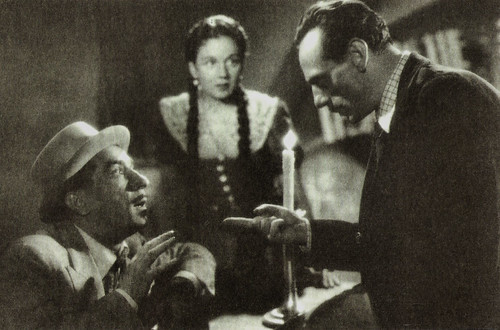
Italian postcard. Photo: publicity still of Casanova farebbe così/Casanova Would Do It That Way! (Carlo Ludovico Bragaglia, 1942) with Peppino and Eduardo De Filippo and in between them Clelia Matania.
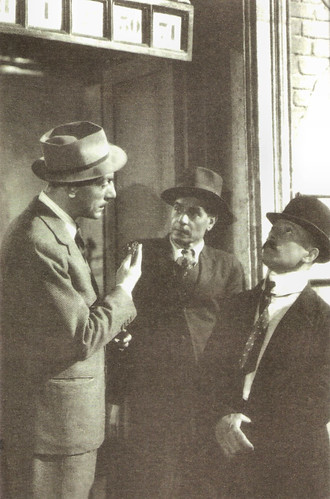
Italian postcard. Eduardo De Filippo and Totò in one of their many comedies.
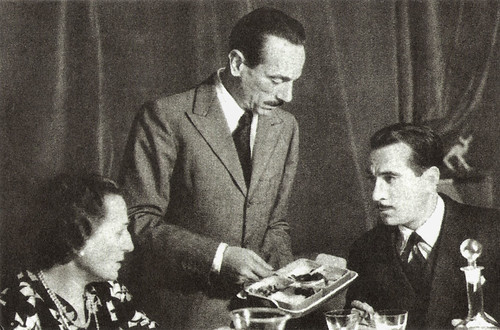
Italian postcard. Photo of Titina, Eduardo and Peppino De Filippo .
Life Begins Anew
Eduardo De Filippo founded the Compagnia di Eduardo, which in 1946 staged Questi fantasmi (Ghosts - Italian Style), followed by the hugely successful Filumena Marturano, which was to become the most famous role of his sister Titina.
Other plays were Napoli milionaria (The Millions of Naples, 1945), Le voci di dentro (Inner Voices, 1948), Mia famiglia (Family of Mine, 1955) and Sabato, domenica e lunedì (Saturday, Sunday and Monday, 1959).
In the cinema, he appeared with Alida Valli and Fosco Giachetti in the drama La vita ricomincia/Life Begins Anew (Mario Mattoli. 1945). It was the second most popular Italian film of the year after Roberto Rossellini's Paisan.
He also appeared in dramas like Assunta Spina/Scarred (Mario Mattoli, 1948) starring Anna Magnani , but De Filippo is better known for his comedies like Napoli milionaria/The Millions of Naples (Eduardo De Filippo, 1950) based on his own play, Filumena Marturano (Eduardo De Filippo, 1951) featuring Titina and the anthology film L'oro di Napoli/The Gold of Naples ( Vittorio De Sica , 1954). In a segment with Tina Pica he played ‘professor’ Ersilio Micci, a ‘wisdom seller’ solving problems.
In 1964, Filomena Maurano was filmed again as Matrimonio all'italiana/Marriage Italian Style ( Vittorio De Sica , 1964) starring Sophia Loren and Marcello Mastroianni .
One of De Filippo’s most successful films as a director was Fortunella/Happy-go-lucky Girl (Eduardo De Filippo, 1958) featuring Giulietta Massina . Other interesting films are L'amore più bello/The Most Beautiful Love (Glauco Pellegrini, 1958) with Alida Valli and child star Edoardo Nevola, the war drama Tutti a casa/ Everybody Go Home (Luigi Comencini, 1960) with Alberto Sordi, and the fantasy Fantasmi a Roma/Ghosts of Rome (Antonio Pietrangeli, 1961) starring Marcello Mastroianni.
Later he mostly appeared on television. In 1973 his play Sabato, domenica e lunedì (Saturday, Sunday and Monday, 1959), was put on at the Old Vic theatre in London. The production directed by Franco Zeffirelli and starring Laurence Olivier , won the London drama critics' award.
In 1981, Eduardo De Filippo was appointed life senator of the Italian Republic. He died four years later in Rome at the age of 84.
His last screen appearance was in the TV mini-series Cuore/Heart (Luigi Comencini, 1984) with Johnny Dorelli.
De Filippo was married three or maybe four times: to Vanna Polverosi (?), Dorothy Pennington (1928-1956), Thea Prandi (1956-1959), with whom he had two children, and to Isabella Quarantotti (1977-1984). His artistic legacy has been carried over by his son, Luca De Filippo.
His plays are often used for TV films, such as Filumena Marturano (Franza Di Rosa, 2010) featuring Mariangela Melato and Sabato, domenica e lunedì/Saturday, Sunday and Monday (Franza Di Rosa, 2012) with Massimo Ranieri.
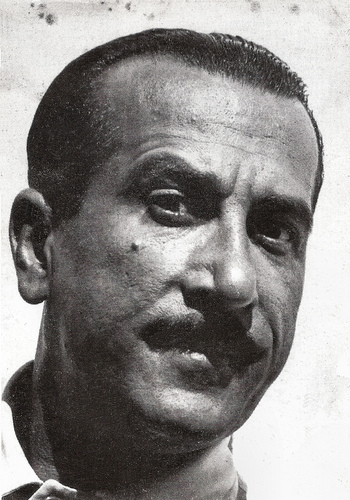
Peppino De Filippo . Italian postcard in the series Gli Artisti di Napoli.
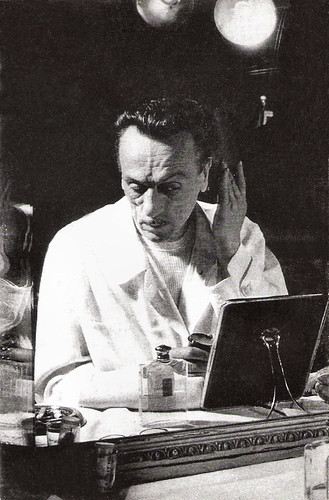
Italian postcard in the series Gli Artisti di Napoli.
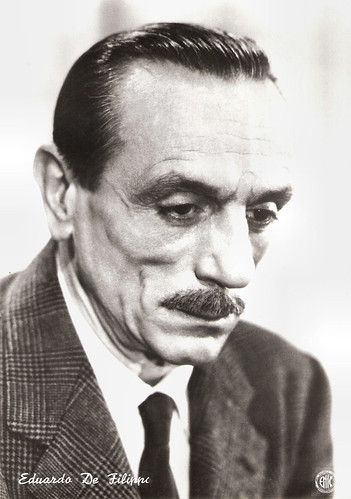
Italian postcard by Bromofoto, Milano, no. 969. Photo: ENIC. Eduardo De Filippo in Traviata '53 (Vittorio Cottafavi, 1953).
Sources: (IMDb), Italica, Wikipedia and

Italian postcard.

Italian postcard. Film scene with at left Titina de Filippo and right Eduardo De Filippo. In between them an unknown actress.

Italian postcard.
I do not pay you!
Eduardo De Filippo was born in Naples, Italy in 1900. He was the illegitimate son of actor/playwright Eduardo Scarpetta and theatre seamstress/costumer Luisa De Filippo. His sister was actress Titina De Filippo and his brother was actor/writer Peppino De Filippo .
Eduardo began acting at the age of four or five, the sources differ. According to Italica , the website of Rai International, he made his debut in 1904 as a Japanese child in La geisha (The Geisha), written by his father. The next year, he was Peppiniello in his father's comedy Miseria e nobiltà (Poverty and Nobility).
In 1914 he joined the regular staff of his step-brother Eduardo Scarpetta's theatre company, where he stayed until 1920 when he was called up for military service. In 1922, on completing his military service, he resumed his acting career in the theatre.
Like his father, he also started to write for the stage. Among his early plays are Farmacia di turno (The All-night Chemist, 1920), Uomo e galantuomo (Man and Gentleman, 1922), Requie a l'anema soja/I morti non fanno paura (May his soul rest, 1926) and Filosoficamente (Philosophically, 1928).
In the early 1930s, he wrote Ogni anno punto e da capo (Every Year Back from the Start, 1931), È arrivato 'o trentuno (The 31st is Here, 1931), Natale in casa Cupiello (Christmas at the Cupiello's, 1931) and La voce del padrone/Il successo del giorno (Success of the Day, 1932).
In 1932 he formed a theatre company with his brother Peppino and sister Titina, called Compagnia del Teatro Umoristico I De Filippo.
From 1933 they also appeared in films. In the French-Italian comedy Tre uomini in frack/Three Lucky Fools (Mario Bonnard, 1933), Eduardo co-starred with opera tenor Tito Schipa and French actor Fred Pasquali.
It was followed by Il cappello a tre punte/Three Cornered Hat (Mario Camerini, 1934) and Quei due/These two (Gennaro Righelli, 1935). He started to directed the comedies he starred in, like In campagna è caduta una stella/In the Country Fell a Star (Eduardo De Filippo, 1939).
With Titina and Peppino De Filippo , he played in the comedy Non ti pago!/I do not pay you! (Carlo Ludovico Bragaglia, 1942), which he also co-wrote. The trio enjoyed success in both mediums, but broke up soon after World War II ended.

Italian postcard. Photo: publicity still of Casanova farebbe così/Casanova Would Do It That Way! (Carlo Ludovico Bragaglia, 1942) with Peppino and Eduardo De Filippo and in between them Clelia Matania.

Italian postcard. Eduardo De Filippo and Totò in one of their many comedies.

Italian postcard. Photo of Titina, Eduardo and Peppino De Filippo .
Life Begins Anew
Eduardo De Filippo founded the Compagnia di Eduardo, which in 1946 staged Questi fantasmi (Ghosts - Italian Style), followed by the hugely successful Filumena Marturano, which was to become the most famous role of his sister Titina.
Other plays were Napoli milionaria (The Millions of Naples, 1945), Le voci di dentro (Inner Voices, 1948), Mia famiglia (Family of Mine, 1955) and Sabato, domenica e lunedì (Saturday, Sunday and Monday, 1959).
In the cinema, he appeared with Alida Valli and Fosco Giachetti in the drama La vita ricomincia/Life Begins Anew (Mario Mattoli. 1945). It was the second most popular Italian film of the year after Roberto Rossellini's Paisan.
He also appeared in dramas like Assunta Spina/Scarred (Mario Mattoli, 1948) starring Anna Magnani , but De Filippo is better known for his comedies like Napoli milionaria/The Millions of Naples (Eduardo De Filippo, 1950) based on his own play, Filumena Marturano (Eduardo De Filippo, 1951) featuring Titina and the anthology film L'oro di Napoli/The Gold of Naples ( Vittorio De Sica , 1954). In a segment with Tina Pica he played ‘professor’ Ersilio Micci, a ‘wisdom seller’ solving problems.
In 1964, Filomena Maurano was filmed again as Matrimonio all'italiana/Marriage Italian Style ( Vittorio De Sica , 1964) starring Sophia Loren and Marcello Mastroianni .
One of De Filippo’s most successful films as a director was Fortunella/Happy-go-lucky Girl (Eduardo De Filippo, 1958) featuring Giulietta Massina . Other interesting films are L'amore più bello/The Most Beautiful Love (Glauco Pellegrini, 1958) with Alida Valli and child star Edoardo Nevola, the war drama Tutti a casa/ Everybody Go Home (Luigi Comencini, 1960) with Alberto Sordi, and the fantasy Fantasmi a Roma/Ghosts of Rome (Antonio Pietrangeli, 1961) starring Marcello Mastroianni.
Later he mostly appeared on television. In 1973 his play Sabato, domenica e lunedì (Saturday, Sunday and Monday, 1959), was put on at the Old Vic theatre in London. The production directed by Franco Zeffirelli and starring Laurence Olivier , won the London drama critics' award.
In 1981, Eduardo De Filippo was appointed life senator of the Italian Republic. He died four years later in Rome at the age of 84.
His last screen appearance was in the TV mini-series Cuore/Heart (Luigi Comencini, 1984) with Johnny Dorelli.
De Filippo was married three or maybe four times: to Vanna Polverosi (?), Dorothy Pennington (1928-1956), Thea Prandi (1956-1959), with whom he had two children, and to Isabella Quarantotti (1977-1984). His artistic legacy has been carried over by his son, Luca De Filippo.
His plays are often used for TV films, such as Filumena Marturano (Franza Di Rosa, 2010) featuring Mariangela Melato and Sabato, domenica e lunedì/Saturday, Sunday and Monday (Franza Di Rosa, 2012) with Massimo Ranieri.

Peppino De Filippo . Italian postcard in the series Gli Artisti di Napoli.

Italian postcard in the series Gli Artisti di Napoli.

Italian postcard by Bromofoto, Milano, no. 969. Photo: ENIC. Eduardo De Filippo in Traviata '53 (Vittorio Cottafavi, 1953).
Sources: (IMDb), Italica, Wikipedia and
Published on June 27, 2019 22:00
A Neapolitan at Cinécittà, Eduardo De Filippo the Filmmaker
We're in Bologna, Italy, and like every year, EFSP follows Cinema Ritrovato! This festival we like to discover the genius of Neapolitan actor-director Eduardo De Filippo (1900-1985) as filmmaker in Cinécitta. This towering, multifaceted figure of Italian culture was best known for his plays Filumena Marturano and Napoli Milionaria. He began to direct films in 1940. During the 1950s, he turned out a string of successful light comedies, many based on his own plays. In addition to writing and directing his own films, he also wrote or collaborated on films with such directors as Vittorio De Sica.

Italian postcard.

Italian postcard. Film scene with at left Titina de Filippo and right Eduardo De Filippo. In between them an unknown actress.

Italian postcard.
Do not pay!
Eduardo De Filippo was born in Naples, Italy in 1900. He was the illegitimate son of actor/playwright Eduardo Scarpetta and theatre seamstress/costumer Luisa De Filippo. His sister was actress Titina De Filippo and his brother actor/writer Peppino De Filippo .
Eduardo began acting at the age of four or five, the sources differ. According to Italica , the website of Rai International, he made his debut in 1904 as a Japanese child in La geisha (The Geisha), written by his father. The next year, he was Peppiniello in his father's comedy Miseria e Nobiltà (Poverty and Nobility).
In 1914 he joined the regular staff of his step-brother Eduardo Scarpetta's theatre company, where he stayed until 1920 when he was called up for military service. In 1922, on completing his military service, he resumed his acting career in the theatre.
Like his father, he also started to write for the stage. Among his early plays are Farmacia di turno (The All-night Chemist, 1920), Uomo e galantuomo (Man and Gentleman, 1922), Requie a l'anema soja/I morti non fanno paura (May his soul rest, 1926) and Filosoficamente (Philosophically, 1928).
In the early 1930s he wrote Ogni anno punto e da capo (Every Year Back from the Start, 1931), È arrivato 'o trentuno (The 31st is Here, 1931), Natale in casa Cupiello (Christmas at the Cupiello's, 1931) and La voce del padrone/Il successo del giorno (Success of the Day, 1932).
In 1932 he formed a theatre company with his brother Peppino and sister Titina, called compagnia del Teatro Umoristico I De Filippo.
From 1933 they also appeared in films. In the French-Italian comedy Tre uomini in frack/Three Lucky Fools (Mario Bonnard, 1933), Eduardo co-starred with opera tenor Tito Schipa and French actor Fred Pasquali.
It was followed by Il cappello a tre punte/Three Cornered Hat (Mario Camerini, 1934) and Quei due (Gennaro Righelli, 1935). He started to directed the comedies he starred in, like In campagna è caduta una stella/In the Country Fell a Star (Eduardo De Filippo, 1939).
With Titina and Peppino De Filippo , he played in the comedy Non ti pago!/Do not pay! (Carlo Ludovico Bragaglia, 1942), which he also co-wrote. The trio enjoyed success in both mediums, but broke up soon after World War II ended.

Italian postcard. Photo: publicity still of Casanova farebbe così/Casanova Would Do It That Way! (Carlo Ludovico Bragaglia, 1942) with Peppino and Eduardo De Filippo and in between them Clelia Matania.

Italian postcard. Eduardo De Filippo and Totó in one of their many comedies.

Italian postcard. Photo of Titina, Eduardo and Peppino De Filippo .
Life Begins Anew
Eduardo De Filippo founded the Compagnia di Eduardo, which in 1946 staged Questi fantasmi (Ghosts - Italian Style), followed by the hugely successful Filumena Marturano, which was to become the most famous role of his sister Titina.
Other plays were Napoli milionaria (The Millions of Naples, 1945), Le voci di dentro (Inner Voices, 1948), Mia famiglia (Family of Mine, 1955) and Sabato, domenica e lunedì (Saturday, Sunday and Monday, 1959).
In the cinema he appeared with Alida Valli and Fosco Giachetti in the drama La vita ricomincia/Life Begins Anew (Mario Mattoli. 1945). It was the second most popular Italian film of the year after Roberto Rossellini's Paisan.
He also appeared in dramas like Assunta Spina/Scarred (Mario Mattoli, 1948) starring Anna Magnani , but De Filippo is better known for his comedies like Napoli milionaria/The Millions of Naples (Eduardo De Filippo, 1950) based on his own play, Filumena Marturano (Eduardo De Filippo, 1951) featuring Titiana and the anthology film L'oro di Napoli/The Gold of Naples ( Vittorio De Sica , 1954). In a segment with Tina Pica he played ‘professor’ Ersilio Micci, a ‘wisdom seller’ solving problems.
In 1964, Filomena Maurano was filmed again as Matrimonio all'italiana/Marriage Italian Style ( Vittorio De Sica , 1964) starring Sophia Loren and Marcello Mastroianni .
One of De Filippo’s most successful films as a director was Fortunella/Happy-go-lucky Girl (Eduardo De Filippo, 1958) featuring Giulietta Massina . Other interesting films are L'amore più bello/The Most Beautiful Love (Glauco Pellegrini, 1958) with Alida Valli and child star Edoardo Nevola, the war drama Tutti a casa/ Everybody Go Home (Luigi Comencini, 1960) with Alberto Sordi, and the fantasy Fantasmi a Roma/Ghosts of Rome (Antonio Pietrangeli, 1961) starring Marcello Mastroianni.
Later he mostly appeared on television. In 1973 his play Sabato, domenica e lunedi (Saturday, Sunday and Monday, 1959), was put on at the Old Vic theatre in London. The production directed by Franco Zeffirelli and starring Laurence Olivier , won the London drama critics' award.
In 1981, Eduardo De Filippo was appointed life senator of the Italian Republic. He died four years later in Rome at the age of 84.
His last screen appearance was in the TV mini-series Cuore/Heart (Luigi Comencini, 1984) with Johnny Dorelli.
De Filippo was married three or maybe four times: to Vanna Polverosi (?), Dorothy Pennington (1928-1956), Thea Prandi (1956-1959), with whom he had two children, and to Isabella Quarantotti (1977-1984). His artistic legacy has been carried over by his son, Luca De Filippo.
His plays are often used for TV films, such as Filumena Marturano (Franza Di Rosa, 2010) featuring Mariangela Melato and Sabato, domenica e lunedì/Saturday, Sunday and Monday (Franza Di Rosa, 2012) with Massimo Ranieri.

Peppino De Filippo . Italian postcard in the series Gli Artisti di Napoli.

Italian postcard in the series Gli Artisti di Napoli.

Italian postcard by Bromofoto, Milano, no. 969. Photo: ENIC. Eduardo De Filippo in Traviata '53 (Vittorio Cottafavi, 1953).
Sources: (IMDb), Italica, Wikipedia and

Italian postcard.

Italian postcard. Film scene with at left Titina de Filippo and right Eduardo De Filippo. In between them an unknown actress.

Italian postcard.
Do not pay!
Eduardo De Filippo was born in Naples, Italy in 1900. He was the illegitimate son of actor/playwright Eduardo Scarpetta and theatre seamstress/costumer Luisa De Filippo. His sister was actress Titina De Filippo and his brother actor/writer Peppino De Filippo .
Eduardo began acting at the age of four or five, the sources differ. According to Italica , the website of Rai International, he made his debut in 1904 as a Japanese child in La geisha (The Geisha), written by his father. The next year, he was Peppiniello in his father's comedy Miseria e Nobiltà (Poverty and Nobility).
In 1914 he joined the regular staff of his step-brother Eduardo Scarpetta's theatre company, where he stayed until 1920 when he was called up for military service. In 1922, on completing his military service, he resumed his acting career in the theatre.
Like his father, he also started to write for the stage. Among his early plays are Farmacia di turno (The All-night Chemist, 1920), Uomo e galantuomo (Man and Gentleman, 1922), Requie a l'anema soja/I morti non fanno paura (May his soul rest, 1926) and Filosoficamente (Philosophically, 1928).
In the early 1930s he wrote Ogni anno punto e da capo (Every Year Back from the Start, 1931), È arrivato 'o trentuno (The 31st is Here, 1931), Natale in casa Cupiello (Christmas at the Cupiello's, 1931) and La voce del padrone/Il successo del giorno (Success of the Day, 1932).
In 1932 he formed a theatre company with his brother Peppino and sister Titina, called compagnia del Teatro Umoristico I De Filippo.
From 1933 they also appeared in films. In the French-Italian comedy Tre uomini in frack/Three Lucky Fools (Mario Bonnard, 1933), Eduardo co-starred with opera tenor Tito Schipa and French actor Fred Pasquali.
It was followed by Il cappello a tre punte/Three Cornered Hat (Mario Camerini, 1934) and Quei due (Gennaro Righelli, 1935). He started to directed the comedies he starred in, like In campagna è caduta una stella/In the Country Fell a Star (Eduardo De Filippo, 1939).
With Titina and Peppino De Filippo , he played in the comedy Non ti pago!/Do not pay! (Carlo Ludovico Bragaglia, 1942), which he also co-wrote. The trio enjoyed success in both mediums, but broke up soon after World War II ended.

Italian postcard. Photo: publicity still of Casanova farebbe così/Casanova Would Do It That Way! (Carlo Ludovico Bragaglia, 1942) with Peppino and Eduardo De Filippo and in between them Clelia Matania.

Italian postcard. Eduardo De Filippo and Totó in one of their many comedies.

Italian postcard. Photo of Titina, Eduardo and Peppino De Filippo .
Life Begins Anew
Eduardo De Filippo founded the Compagnia di Eduardo, which in 1946 staged Questi fantasmi (Ghosts - Italian Style), followed by the hugely successful Filumena Marturano, which was to become the most famous role of his sister Titina.
Other plays were Napoli milionaria (The Millions of Naples, 1945), Le voci di dentro (Inner Voices, 1948), Mia famiglia (Family of Mine, 1955) and Sabato, domenica e lunedì (Saturday, Sunday and Monday, 1959).
In the cinema he appeared with Alida Valli and Fosco Giachetti in the drama La vita ricomincia/Life Begins Anew (Mario Mattoli. 1945). It was the second most popular Italian film of the year after Roberto Rossellini's Paisan.
He also appeared in dramas like Assunta Spina/Scarred (Mario Mattoli, 1948) starring Anna Magnani , but De Filippo is better known for his comedies like Napoli milionaria/The Millions of Naples (Eduardo De Filippo, 1950) based on his own play, Filumena Marturano (Eduardo De Filippo, 1951) featuring Titiana and the anthology film L'oro di Napoli/The Gold of Naples ( Vittorio De Sica , 1954). In a segment with Tina Pica he played ‘professor’ Ersilio Micci, a ‘wisdom seller’ solving problems.
In 1964, Filomena Maurano was filmed again as Matrimonio all'italiana/Marriage Italian Style ( Vittorio De Sica , 1964) starring Sophia Loren and Marcello Mastroianni .
One of De Filippo’s most successful films as a director was Fortunella/Happy-go-lucky Girl (Eduardo De Filippo, 1958) featuring Giulietta Massina . Other interesting films are L'amore più bello/The Most Beautiful Love (Glauco Pellegrini, 1958) with Alida Valli and child star Edoardo Nevola, the war drama Tutti a casa/ Everybody Go Home (Luigi Comencini, 1960) with Alberto Sordi, and the fantasy Fantasmi a Roma/Ghosts of Rome (Antonio Pietrangeli, 1961) starring Marcello Mastroianni.
Later he mostly appeared on television. In 1973 his play Sabato, domenica e lunedi (Saturday, Sunday and Monday, 1959), was put on at the Old Vic theatre in London. The production directed by Franco Zeffirelli and starring Laurence Olivier , won the London drama critics' award.
In 1981, Eduardo De Filippo was appointed life senator of the Italian Republic. He died four years later in Rome at the age of 84.
His last screen appearance was in the TV mini-series Cuore/Heart (Luigi Comencini, 1984) with Johnny Dorelli.
De Filippo was married three or maybe four times: to Vanna Polverosi (?), Dorothy Pennington (1928-1956), Thea Prandi (1956-1959), with whom he had two children, and to Isabella Quarantotti (1977-1984). His artistic legacy has been carried over by his son, Luca De Filippo.
His plays are often used for TV films, such as Filumena Marturano (Franza Di Rosa, 2010) featuring Mariangela Melato and Sabato, domenica e lunedì/Saturday, Sunday and Monday (Franza Di Rosa, 2012) with Massimo Ranieri.

Peppino De Filippo . Italian postcard in the series Gli Artisti di Napoli.

Italian postcard in the series Gli Artisti di Napoli.

Italian postcard by Bromofoto, Milano, no. 969. Photo: ENIC. Eduardo De Filippo in Traviata '53 (Vittorio Cottafavi, 1953).
Sources: (IMDb), Italica, Wikipedia and
Published on June 27, 2019 22:00
June 26, 2019
In search of colour - Miriam Hopkins
In 1935, the arrival of Becky Sharp, the first feature-length Technicolor film, forever changed the vision of film viewers around the world. The three colours of the new process were so beautiful they could transcend the reality. Not only had cinema made the coveted technological achievement of colour reproduction, but the process also made such brilliant and blazing colours that it perhaps was the most dazzling technology that audiences had ever experienced since the arrival of sound! It instantly became a new, richly nuanced means of expression. Becky Sharp (Rouben Mamoulian, 1935), featuring the great Miriam Hopkins (1902-1972), is one of the highlights of the In search of colour programme at Cinema Ritrovato in Bologna. Hopkins had joined Paramount in 1930, after ten years on the stage as a successful actress. She soon became one of Hollywood's top-ranking stars. When her film career slowed in the 1940s, she returned to the stage, and during the 1950s she added television to her repertoire.
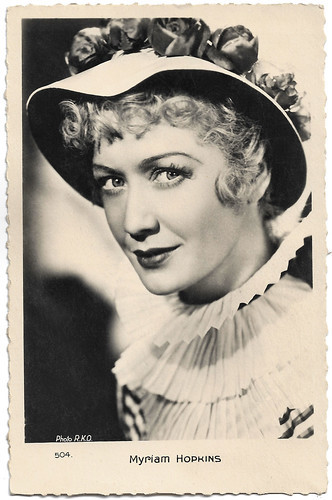
French postcard by Editions EC, Paris, no. 504. Photo: RKO. Miriam Hopkins in Becky Sharp (Rouben Mamoulian, 1935).

German postcard by Ross Verlag, no. 5976/1, 1931-1932. Photo: Paramount. Maurice Chevalier and Miriam Hopkins in The Smiling Lieutenant (Ernst Lubitsch, 1931).
A rebellious girl as a good start
Ellen Miriam Hopkins was born into wealth in Savannah, Georgia in 1902. Her parents were Homer Hopkins and Ellen Cutler.
She spent most of her formative years with her maternal grandmother. After her parents separated, she moved as a teen with her mother to Syracuse, New York to be near her uncle, Thomas Cramer Hopkins, head of the geology department at Syracuse University.
She attended Goddard Seminary in Barre, Vermont and Syracuse University. Upon graduation, she decided to become a ballet dancer. Studying dance in New York, she received her first taste of show business as a chorus girl at twenty.
Hopkins appeared in Broadway revues and vaudeville before she began expanding her horizons by trying out dramatic roles four years later. By 1928, Miriam was appearing in stock companies on the East Coast and her reviews were getting better after having been vilified earlier in her career.
In 1930, Miriam decided to try the silver screen and signed with Paramount Studios. Since she was already established on Broadway, Paramount felt they were getting a seasoned performer after the rave reviews she had received on Broadway. Her first role was opposite Carole Lombard in Fast and Loose (Fred C. Newmeyer, 1930). Her role as a rebellious girl was a good start.
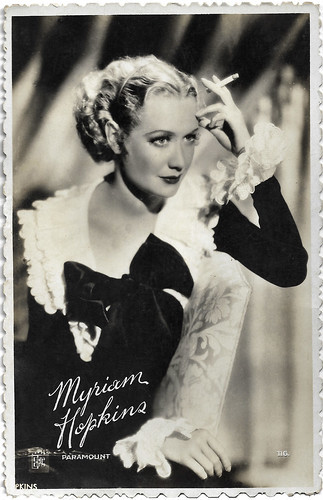
French postcard by EPC, no. 116. Photo: Paramount.
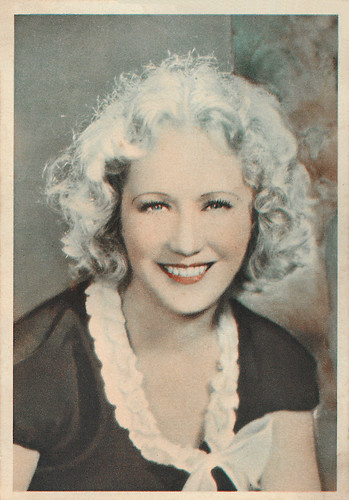
British postcard by De Reszke Cigarettes, no. 36. Photo: Radio (RKO).
A talent that had all the earmarks of stardom
Miriam Hopkins was killed by her husband (Regis Toomey) in 24 Hours (Marion Gering, 1931). She played Princess Anna in The Smiling Lieutenant (Ernst Lubitsch, 1931) opposite Maurice Chevalier . Still considered a newcomer, Miriam displayed a talent that had all the earmarks of stardom.
She was to finish out the year by playing the prostitute Ivy Pearson in Dr. Jekyll and Mr. Hyde (Rouben Mamoulian, 1931) featuring Fredric March. She received rave reviews, but because of the character's and film's potential controversy, many of her scenes were cut before the official release, reducing her screen time to about five minutes.
Miriam began filming The World and the Flesh (John Cromwell, 1932) with George Bancroft, which was not a box-office blockbuster. Later, she appeared in Dancers in the Dark (David Burton, 1932) with George Raft. The film was unexpectedly strong and enjoyable which served as a catalyst to propel Miriam and Raft to bigger stardom.
In Two Kinds of Women (William C. de Mille, 1932), Hopkins once again performed magnificently. Later that year she played beautiful and jealous pickpocket Lily Vautier in the sophisticated comedy Trouble in Paradise (Ernst Lubitsch, 1932) with Kay Francis and Herbert Marshall . Denny Jackson at IMDb : "A film that should have been nominated for an Academy Award, it has lasted through the years as a masterpiece in comedy - even today, film buffs and historians rave about it."
Miriam's brilliant performance opposite Fredric March and Gary Cooper in Design for Living (Ernst Lubitsch, 1933) propelled her to the top of Paramount's salary scale. Later that year, she played the title role in The Story of Temple Drake (Stephen Roberts, 1933). Paramount was forced to tone down the film's violence and character being raped to pass the Hayes Office code. Despite being watered down, it was still a box-office smash.
In 1934, Miriam filmed All of Me (James Flood, 1934) which was less than well-received. She was nominated for the Academy Award for Best Actress for the historical drama Becky Sharp (Rouben Mamoulian, 1935). The film was considered a landmark in cinema as the first feature film to use the newly developed three-strip Technicolor production throughout.
She also starred in the drama These Three (William Wyler, 1936) with Joel McCrea and Bonita Granville. The screenplay by Lillian Hellman was based on her 1934 play 'The Children's Hour'. It was the first of four films, Hopkins would make with director William Wyler.
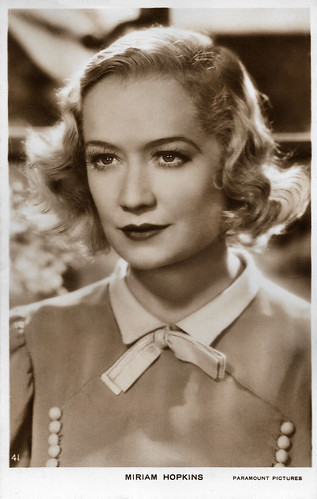
British Real Photograph postcard by Milton Postcard, no. 41. Photo: Paramount Pictures.
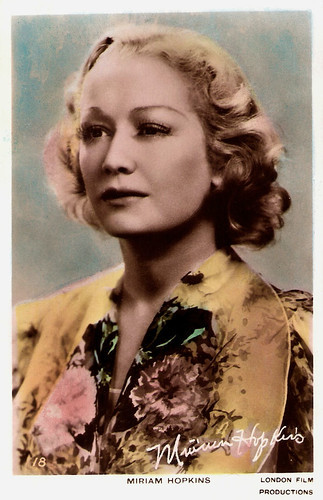
British Real Photograph postcard. Photo: London Film Productions. Miriam Hopkins in Men Are Not Gods (Walter Reisch, 1936).
Two divas in a boxing ring, gloves up
Soon, the country was abuzz as to who would play Scarlett O'Hara in Margaret Mitchell's Gone with the Wind (Victor Fleming, 1939). Miriam Hopkins was Mitchell's first choice to play Scarlett. Hopkins wanted the coveted spot especially since she was a Southern lady and Georgia native. Unfortunately, as we all know, she didn't win the role.
As a matter of fact, her only film role that year was in The Old Maid (Edmund Goulding, 1939) starring opposite her arch-enemy, Bette Davis. By this time, the roles were only trickling in for her. With the slowdown in film work, Miriam Hopkins found herself returning to the stage.
She made two films in 1940, none in 1941, and one in 1942 and 1943, respectively. Hopkins had well-publicised fights with Bette Davis, when they costarred again in Old Acquaintance (1943). Davis admitted to enjoying very much a scene in which she shakes Hopkins forcefully when Hopkins's character makes unfounded allegations against Davis's. Press photos were even taken with the two divas in a boxing ring, gloves up, and director Vincent Sherman between them like a referee. Davis described Hopkins as a "terribly good actress", but also "terribly jealous" in later interviews.
For Hopkins, the stage was her work now. However, in 1949, she received the role of Lavinia Penniman in The Heiress (William Wyler, 1949), starring Olivia de Havilland and Montgomery Clift.
Hopkins made only three films in the 1950s, but she had begun making appearances on such television programmes as The Chevrolet Tele-Theatre (1949), Pulitzer Prize Playhouse (1951), and Lux Video Theatre (1951-1955). She later guest-starred on dramatic series like The Outer Limits (1964) and an episode of The Flying Nun (1969).
Hopkins made her final big screen appearance in the horror thriller Savage Intruder (Donald Wolfe, 1970) as an ageing, drunken and washed-out film star living in a decaying mansion in Hollywood Hills.
In July 1972, despite concerns about her health and a premonition that she shouldn't travel, she flew to New York to attend the special screening of Story of Temple Drake, celebrating the 60th anniversary of Paramount Pictures, followed by a gala party in her honour at the Museum of Modern Art. Just as she had feared, she suffered a major heart attack and died in her hotel suite before getting back to her California home. She was 69.
Hopkins had married and divorced four times. Her husbands were Brandon Peters (1926-1928), Austin Parker (1928-1932), film director Anatole Litvak (1937-1939), and Raymond Benton Brock (1945-1951). In 1932, at a time when single-parent adoption was illegal in most states, she adopted a baby boy while between marriages. She adored her son, Michael, and always called him the most important man in her life.
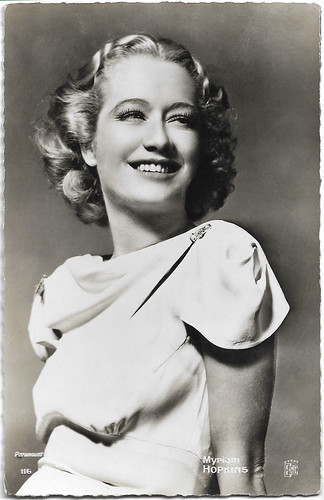
French postcard by EPC, no. 116. Photo: Paramount.
Sources: (IMDb), (IMDb), Wikipedia and .

French postcard by Editions EC, Paris, no. 504. Photo: RKO. Miriam Hopkins in Becky Sharp (Rouben Mamoulian, 1935).

German postcard by Ross Verlag, no. 5976/1, 1931-1932. Photo: Paramount. Maurice Chevalier and Miriam Hopkins in The Smiling Lieutenant (Ernst Lubitsch, 1931).
A rebellious girl as a good start
Ellen Miriam Hopkins was born into wealth in Savannah, Georgia in 1902. Her parents were Homer Hopkins and Ellen Cutler.
She spent most of her formative years with her maternal grandmother. After her parents separated, she moved as a teen with her mother to Syracuse, New York to be near her uncle, Thomas Cramer Hopkins, head of the geology department at Syracuse University.
She attended Goddard Seminary in Barre, Vermont and Syracuse University. Upon graduation, she decided to become a ballet dancer. Studying dance in New York, she received her first taste of show business as a chorus girl at twenty.
Hopkins appeared in Broadway revues and vaudeville before she began expanding her horizons by trying out dramatic roles four years later. By 1928, Miriam was appearing in stock companies on the East Coast and her reviews were getting better after having been vilified earlier in her career.
In 1930, Miriam decided to try the silver screen and signed with Paramount Studios. Since she was already established on Broadway, Paramount felt they were getting a seasoned performer after the rave reviews she had received on Broadway. Her first role was opposite Carole Lombard in Fast and Loose (Fred C. Newmeyer, 1930). Her role as a rebellious girl was a good start.

French postcard by EPC, no. 116. Photo: Paramount.

British postcard by De Reszke Cigarettes, no. 36. Photo: Radio (RKO).
A talent that had all the earmarks of stardom
Miriam Hopkins was killed by her husband (Regis Toomey) in 24 Hours (Marion Gering, 1931). She played Princess Anna in The Smiling Lieutenant (Ernst Lubitsch, 1931) opposite Maurice Chevalier . Still considered a newcomer, Miriam displayed a talent that had all the earmarks of stardom.
She was to finish out the year by playing the prostitute Ivy Pearson in Dr. Jekyll and Mr. Hyde (Rouben Mamoulian, 1931) featuring Fredric March. She received rave reviews, but because of the character's and film's potential controversy, many of her scenes were cut before the official release, reducing her screen time to about five minutes.
Miriam began filming The World and the Flesh (John Cromwell, 1932) with George Bancroft, which was not a box-office blockbuster. Later, she appeared in Dancers in the Dark (David Burton, 1932) with George Raft. The film was unexpectedly strong and enjoyable which served as a catalyst to propel Miriam and Raft to bigger stardom.
In Two Kinds of Women (William C. de Mille, 1932), Hopkins once again performed magnificently. Later that year she played beautiful and jealous pickpocket Lily Vautier in the sophisticated comedy Trouble in Paradise (Ernst Lubitsch, 1932) with Kay Francis and Herbert Marshall . Denny Jackson at IMDb : "A film that should have been nominated for an Academy Award, it has lasted through the years as a masterpiece in comedy - even today, film buffs and historians rave about it."
Miriam's brilliant performance opposite Fredric March and Gary Cooper in Design for Living (Ernst Lubitsch, 1933) propelled her to the top of Paramount's salary scale. Later that year, she played the title role in The Story of Temple Drake (Stephen Roberts, 1933). Paramount was forced to tone down the film's violence and character being raped to pass the Hayes Office code. Despite being watered down, it was still a box-office smash.
In 1934, Miriam filmed All of Me (James Flood, 1934) which was less than well-received. She was nominated for the Academy Award for Best Actress for the historical drama Becky Sharp (Rouben Mamoulian, 1935). The film was considered a landmark in cinema as the first feature film to use the newly developed three-strip Technicolor production throughout.
She also starred in the drama These Three (William Wyler, 1936) with Joel McCrea and Bonita Granville. The screenplay by Lillian Hellman was based on her 1934 play 'The Children's Hour'. It was the first of four films, Hopkins would make with director William Wyler.

British Real Photograph postcard by Milton Postcard, no. 41. Photo: Paramount Pictures.

British Real Photograph postcard. Photo: London Film Productions. Miriam Hopkins in Men Are Not Gods (Walter Reisch, 1936).
Two divas in a boxing ring, gloves up
Soon, the country was abuzz as to who would play Scarlett O'Hara in Margaret Mitchell's Gone with the Wind (Victor Fleming, 1939). Miriam Hopkins was Mitchell's first choice to play Scarlett. Hopkins wanted the coveted spot especially since she was a Southern lady and Georgia native. Unfortunately, as we all know, she didn't win the role.
As a matter of fact, her only film role that year was in The Old Maid (Edmund Goulding, 1939) starring opposite her arch-enemy, Bette Davis. By this time, the roles were only trickling in for her. With the slowdown in film work, Miriam Hopkins found herself returning to the stage.
She made two films in 1940, none in 1941, and one in 1942 and 1943, respectively. Hopkins had well-publicised fights with Bette Davis, when they costarred again in Old Acquaintance (1943). Davis admitted to enjoying very much a scene in which she shakes Hopkins forcefully when Hopkins's character makes unfounded allegations against Davis's. Press photos were even taken with the two divas in a boxing ring, gloves up, and director Vincent Sherman between them like a referee. Davis described Hopkins as a "terribly good actress", but also "terribly jealous" in later interviews.
For Hopkins, the stage was her work now. However, in 1949, she received the role of Lavinia Penniman in The Heiress (William Wyler, 1949), starring Olivia de Havilland and Montgomery Clift.
Hopkins made only three films in the 1950s, but she had begun making appearances on such television programmes as The Chevrolet Tele-Theatre (1949), Pulitzer Prize Playhouse (1951), and Lux Video Theatre (1951-1955). She later guest-starred on dramatic series like The Outer Limits (1964) and an episode of The Flying Nun (1969).
Hopkins made her final big screen appearance in the horror thriller Savage Intruder (Donald Wolfe, 1970) as an ageing, drunken and washed-out film star living in a decaying mansion in Hollywood Hills.
In July 1972, despite concerns about her health and a premonition that she shouldn't travel, she flew to New York to attend the special screening of Story of Temple Drake, celebrating the 60th anniversary of Paramount Pictures, followed by a gala party in her honour at the Museum of Modern Art. Just as she had feared, she suffered a major heart attack and died in her hotel suite before getting back to her California home. She was 69.
Hopkins had married and divorced four times. Her husbands were Brandon Peters (1926-1928), Austin Parker (1928-1932), film director Anatole Litvak (1937-1939), and Raymond Benton Brock (1945-1951). In 1932, at a time when single-parent adoption was illegal in most states, she adopted a baby boy while between marriages. She adored her son, Michael, and always called him the most important man in her life.

French postcard by EPC, no. 116. Photo: Paramount.
Sources: (IMDb), (IMDb), Wikipedia and .
Published on June 26, 2019 22:00
June 25, 2019
Henri Rollan
EFSP follows Cinema Ritrovato! A silent film I am really looking forward to is René Clair’s debut, Paris qui dort/While Paris sleeps (1923-1925). In this curious film, French actor and stage director Henri Rollan (1888-1967) plays the guardsman of the Eiffel Tower and one of the few people who hasn't fallen asleep. In addition to a rich career on stage, he also acted in many French silent and sound films. Other memorable films with Rollan are the silent and the sound version of Les Trois Mousquetaires/The Three Musketeers by Henri Diamant-Berger.
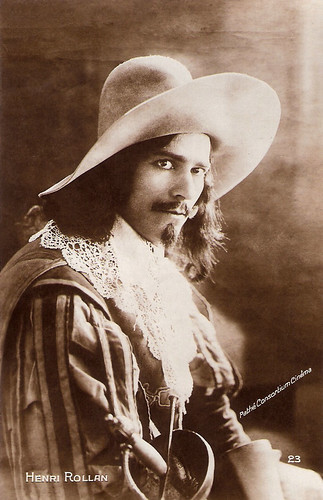
French postcard by Editions Cinémagazine no. 23. Photo: Pathé Consortium Cinéma. Henri Rollan as Athos in Les Trois Mousquetaires/The Three Musketeers (Henri Diamant-Berger, 1921).
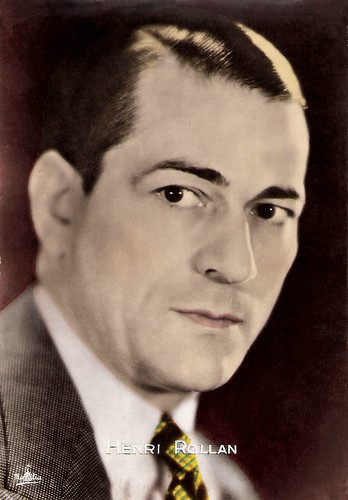
French card by Massilia. The flipside has the handwritten text: "Je suis heureux de pouvoir vous saluer de cette façon un peu inattendue.... aussi inconnue à qui sont dédiés mes efforts, mais qui en pensez... quoi??? Bien sympathiquement... quoi qu'il en soit. Henri Rollan" An undeciphrable signature is added, perhaps that of Rolllan.
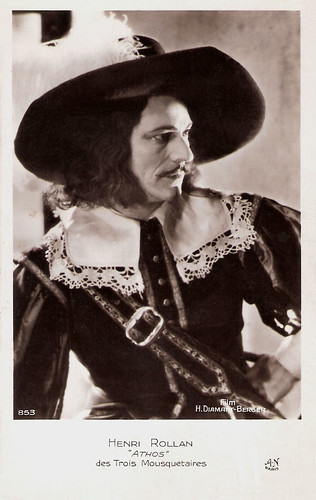
French postcard by A.N., Paris no. 853. Photo: Film H. Diamant-Berger. Henri Rollan as Athos in Les Trois Mousquetaires/The Three Musketeers (Henri Diamant-Berger, 1921).
Ruthless Murderer
Henri Rollan was born as Henri Martine in Paris in 1888.
In 1906 he started his acting career with the great André Antoine at the Theatre de l’Odeon, where he would remain until 1909, playing in classics such as William Shakespeare’s Julius Caesar.
In 1910 Rollan made his film debut, perhaps attracted by previous film contributions by renowned stage actors such as Charles Le Bargy . His first film was probably the Film d’Art production L’Héritière (Henri Pouctal, André Calmettes, 1910) starring Paul Mounet of the Comédie française.
In the same year, Rollan played in the Pathé film L’Amour et le temps (Michel Carré, 1910), a mythological tale starring young Raymonde Dupré as Cupid and thespian Henry Krauss as grumpy old Father Time.
Several more Pathé films followed, such as L’Absent (Albert Capellani, 1913), in which Henri Étievant played the lead as a Dutch farmer whose son and mother-in-law (Jeanne Grumbach) refuse his second wife ( Germaine Dermoz ) and her daughter. Six years after the whole family reconciles when first the mother-in-law recognises the virtues of the second wife and then the farmer blesses the love between his son (Rollan) and his stepdaughter (Dupré).
In Jeanne la Maudite (1913) Rollan is the ruthless murderer of his uncle, while an innocent lumberjack is imprisoned for the murder. Jeanne, the innocent’s daughter becomes the punch-bag of the village.
In 1914 Rollan played Maurice Lindey in the long running Pathé serial Le Chevalier de Maison-Rouge (Albert Capellani, 1914), adapted from Alexandre Dumas, and with Paul Escoffier as the Chevalier and Marie-Louise Derval as Geneviève Dixmer. Rollan played the lead as a young Republican who unknowingly implicates himself in a plot to rescue Queen Marie-Antoinette during the Reign of Terror. The serial had 6 parts, each split up in 10 episodes.
In 1918 Rollan played in another film serial, this time in 8 episodes: Le baron mystère (Maurice Chaillot, 1918) starring Pierre Alcover.
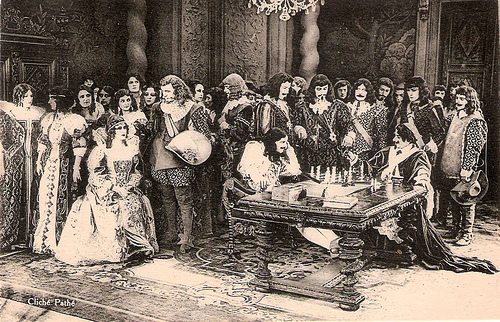
French postcard by M. Le Deley, Paris. Photo: still for Les Trois Mousquetaires (Henri Diamant Berger, 1921).
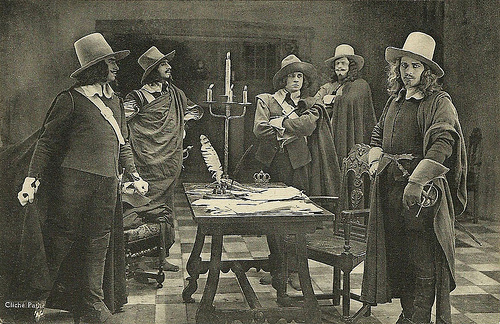
French postcard. Photo: Pathé. Publicity still for Vingt ans après/The Return of the Musketeers (Henri Diamant-Berger, 1922). Collection: Didier Hanson. The four musketeers were played by Jean Yonnel (D'Artagnan), Henri Rollan (Athos), Pierre de Guingand (Aramis) and Charles Martinelli (Porthos).
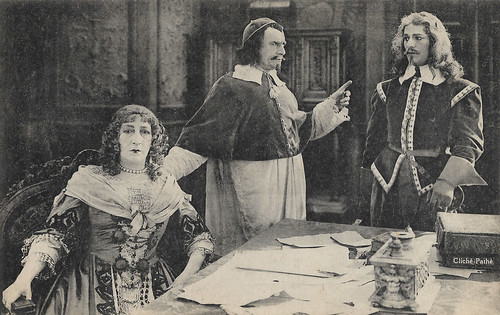
French postcard. Photo: Pathé. Publicity still for Vingt ans après/The Return of the Musketeers (Henri Diamant-Berger, 1922). Marguerite Moreno as Queen-Mother Anne of Austria, Jean Périer as Cardinal Mazarin, and Henri Rollan as Athos.
The Three Musketeers
In 1921 Henri Rollan starred in the SCAGL production Les Trois masques (Henry Krauss, 1921), a story about family feuds and deadly revenge.
In the same year Rollan performed Athos in Les Trois Mousquetaires/The Three Musketeers (Henri Diamant-Berger, 1921), a prestigious Pathé production with lavish sets and many extras. The super-production rivaled Douglas Fairbanks contemporary Three Musketeers of 1921. Together with Charles Martinelli (Porthos), Pierre de Guingand (Aramis) and Aimé Simon-Girard (D’Artagnan), Rollin became a national star.
The success of the film urged Pathé to make the sequel Vingt ans après/Twenty Years After (Henri Diamant-Berger, 1922) in which Martinelli, Guingand and Rollan remained but Jean Yonnel replaced Simon-Girard.
Other films with Rollan in those years were Mimi Trottin (Henri Andréani, 1922), Le Sang d’Allah (Luitz Morat, 1922) and L’Emprise (Henri Diamant-Berger, 1923).
Rollan's last silent film is probably his most famous one, Paris qui dort (René Clair, 1923-1925), in which he starred as Albert, the guardsman of the Eiffel Tower. Together with a group who just flew into Paris, he is the only one to have survived a scientist’s experiment to freeze the whole of Paris. His former buddy from Les Trois Mousquetaires, Charles Martinelli , played the scientist, while Albert Préjean was the pilot. The startling images of the actors on top of the Eiffel Tower and their reckless behaviour still impress today.
Incredibly this was the directing debut of René Clair, even if the film was publicly released after Clair’s next film Entr’acte (1924). Paris qui dort was produced by Henri Diamant-Berger’s company Films Diamant.
After that, Rollin took a break in film acting. He kept playing on stage, and performed at various Parisian theatres – first mainly at the Théàtre de Paris and later at the Théàtre de Port Saint-Martin.

French postcard. Photo: publicity still for Vingt ans après/The Return of the Musketeers (Henri Diamant-Berger, 1922). Photo: Pathé. This could be Athos (Henri Rollan) and his son Raoul (played by actress Pierrette Madd ).
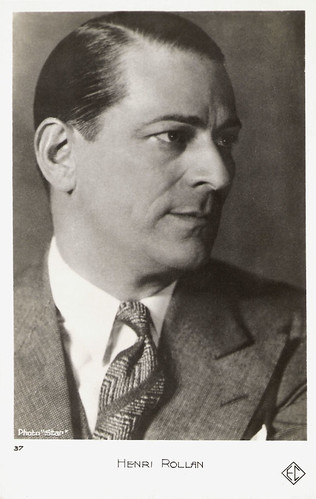
French postcard by EC, no. 37. Photo: Star.
A Tough, Stiff, Humorless Character
When sound cinema set in in France, Henri Diamant-Berger called back his ‘musketeer’ to act in three films. in Sola (1931), Henri Rollan starred opposite Chanson singer Damia . In Clair de lune (1932), he co-starred with Blanche Montel and Claude Dauphin .
The third film was the sound version of Les Trois Mousquetaires (1932), this time set up as a two-episode film instead of a long serial. Ten years after the silent version Rollan again played Athos, now with Thomy Bourdelle as Porthos, Jean-Louis Allibert as Aramis, and Aimé Simon-Girard returned as D’Artagnan, and Blanche Montel as Constance.
During the 1930's, Rollan remained very active in French films, playing in some twenty films, performing opposite actors such as Madeleine Renaud , Gaby Morlay , and Michel Simon , Victor Francen , Madeleine Ozeray , and Huguette Duflos . While most of his directors are forgotten names now, some might ring a bell such as Marcel L’Herbier and the Italian directors Augusto Genina and Mario Bonnard .
During the war Rollan acted in just a few films, and it took until the late 1940s to have his film acting career revived. During the first half of the 1950s, though, Rollan had memorable parts as the incompetent Maréchal d'Estrée in Fanfan la Tulipe (Christian-Jaque, 1951) and a French politician in Les Aventures d'Arsène Lupin (Jacques Becker, 1956).
Rollan’s last film part was in 121 Rue Blanche à Paris (Quinto Albicocco, 1961) which starred stage and film actress Berthe Bovy , who just like Rollan had started out in film at the days of Film d’art.
While Rollan had acted on stage in the 1930s as well, it was in particular from the mid-1940s on that he intensified this. Between the late 1940s and early 1950s he must have been constantly working either on stage or on a film set, despite his age.
Moreover, from 1945 on, he also directed various stage plays and would do so until his death. From 1948 on, Rollan almost exclusively played at the Comédie française, and would do so until 1965. Henri Rollan died in Paris in 1967. He was 79.
As Guy Bellinger writes at IMDb : “He was always a great professional and his performances (most often as a tough, stiff, humorless character endowed with authority) are excellent whatever the film he is in. Of course where he really shone was on stage, as an actor first, later as a renowned director. He was also a much loved and respected drama teacher who guided among others the first steps of Jean Claudio, Jacques Fabbri, Raymond Devos, Anna Gaylor, Annie Girardot, Marie Dubois and Jacques Lorcey. None of these persons ever forgot Henri Rollan, a passionate man who had the gift to transmit his genuine passion to other young passionates.”
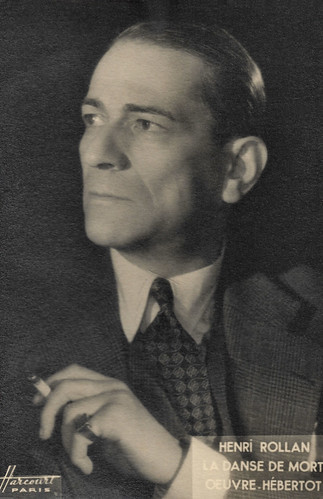
French postcard. Photo: Harcourt, Paris. In 1944, Henri Rollan directed the play La Danse de mort by August Strindberg, for Le Théâtre de l'Œuvre of Jacques Hébertot.
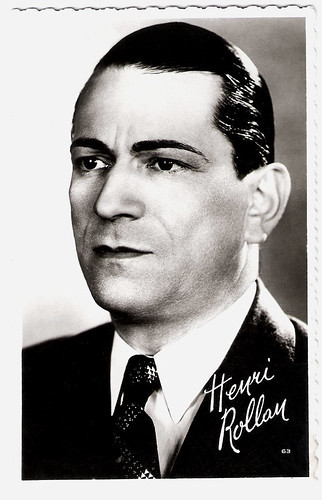
French postcard by Editions et Publications Cinématographiques, no. 63.
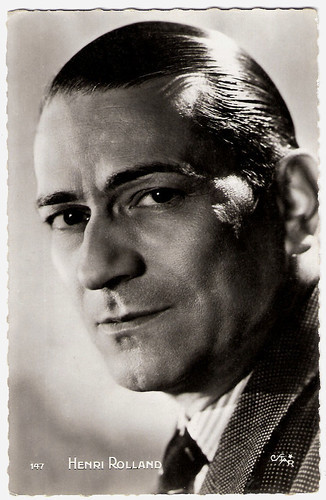
French postcard by Editions P.I., Paris, no. 147. Photo: Star.
Sources: (IMDb), CineArtistes.com (French), Fondation Jerome Seydoux, CineRessources, Wikipedia (French), and .

French postcard by Editions Cinémagazine no. 23. Photo: Pathé Consortium Cinéma. Henri Rollan as Athos in Les Trois Mousquetaires/The Three Musketeers (Henri Diamant-Berger, 1921).

French card by Massilia. The flipside has the handwritten text: "Je suis heureux de pouvoir vous saluer de cette façon un peu inattendue.... aussi inconnue à qui sont dédiés mes efforts, mais qui en pensez... quoi??? Bien sympathiquement... quoi qu'il en soit. Henri Rollan" An undeciphrable signature is added, perhaps that of Rolllan.

French postcard by A.N., Paris no. 853. Photo: Film H. Diamant-Berger. Henri Rollan as Athos in Les Trois Mousquetaires/The Three Musketeers (Henri Diamant-Berger, 1921).
Ruthless Murderer
Henri Rollan was born as Henri Martine in Paris in 1888.
In 1906 he started his acting career with the great André Antoine at the Theatre de l’Odeon, where he would remain until 1909, playing in classics such as William Shakespeare’s Julius Caesar.
In 1910 Rollan made his film debut, perhaps attracted by previous film contributions by renowned stage actors such as Charles Le Bargy . His first film was probably the Film d’Art production L’Héritière (Henri Pouctal, André Calmettes, 1910) starring Paul Mounet of the Comédie française.
In the same year, Rollan played in the Pathé film L’Amour et le temps (Michel Carré, 1910), a mythological tale starring young Raymonde Dupré as Cupid and thespian Henry Krauss as grumpy old Father Time.
Several more Pathé films followed, such as L’Absent (Albert Capellani, 1913), in which Henri Étievant played the lead as a Dutch farmer whose son and mother-in-law (Jeanne Grumbach) refuse his second wife ( Germaine Dermoz ) and her daughter. Six years after the whole family reconciles when first the mother-in-law recognises the virtues of the second wife and then the farmer blesses the love between his son (Rollan) and his stepdaughter (Dupré).
In Jeanne la Maudite (1913) Rollan is the ruthless murderer of his uncle, while an innocent lumberjack is imprisoned for the murder. Jeanne, the innocent’s daughter becomes the punch-bag of the village.
In 1914 Rollan played Maurice Lindey in the long running Pathé serial Le Chevalier de Maison-Rouge (Albert Capellani, 1914), adapted from Alexandre Dumas, and with Paul Escoffier as the Chevalier and Marie-Louise Derval as Geneviève Dixmer. Rollan played the lead as a young Republican who unknowingly implicates himself in a plot to rescue Queen Marie-Antoinette during the Reign of Terror. The serial had 6 parts, each split up in 10 episodes.
In 1918 Rollan played in another film serial, this time in 8 episodes: Le baron mystère (Maurice Chaillot, 1918) starring Pierre Alcover.

French postcard by M. Le Deley, Paris. Photo: still for Les Trois Mousquetaires (Henri Diamant Berger, 1921).

French postcard. Photo: Pathé. Publicity still for Vingt ans après/The Return of the Musketeers (Henri Diamant-Berger, 1922). Collection: Didier Hanson. The four musketeers were played by Jean Yonnel (D'Artagnan), Henri Rollan (Athos), Pierre de Guingand (Aramis) and Charles Martinelli (Porthos).

French postcard. Photo: Pathé. Publicity still for Vingt ans après/The Return of the Musketeers (Henri Diamant-Berger, 1922). Marguerite Moreno as Queen-Mother Anne of Austria, Jean Périer as Cardinal Mazarin, and Henri Rollan as Athos.
The Three Musketeers
In 1921 Henri Rollan starred in the SCAGL production Les Trois masques (Henry Krauss, 1921), a story about family feuds and deadly revenge.
In the same year Rollan performed Athos in Les Trois Mousquetaires/The Three Musketeers (Henri Diamant-Berger, 1921), a prestigious Pathé production with lavish sets and many extras. The super-production rivaled Douglas Fairbanks contemporary Three Musketeers of 1921. Together with Charles Martinelli (Porthos), Pierre de Guingand (Aramis) and Aimé Simon-Girard (D’Artagnan), Rollin became a national star.
The success of the film urged Pathé to make the sequel Vingt ans après/Twenty Years After (Henri Diamant-Berger, 1922) in which Martinelli, Guingand and Rollan remained but Jean Yonnel replaced Simon-Girard.
Other films with Rollan in those years were Mimi Trottin (Henri Andréani, 1922), Le Sang d’Allah (Luitz Morat, 1922) and L’Emprise (Henri Diamant-Berger, 1923).
Rollan's last silent film is probably his most famous one, Paris qui dort (René Clair, 1923-1925), in which he starred as Albert, the guardsman of the Eiffel Tower. Together with a group who just flew into Paris, he is the only one to have survived a scientist’s experiment to freeze the whole of Paris. His former buddy from Les Trois Mousquetaires, Charles Martinelli , played the scientist, while Albert Préjean was the pilot. The startling images of the actors on top of the Eiffel Tower and their reckless behaviour still impress today.
Incredibly this was the directing debut of René Clair, even if the film was publicly released after Clair’s next film Entr’acte (1924). Paris qui dort was produced by Henri Diamant-Berger’s company Films Diamant.
After that, Rollin took a break in film acting. He kept playing on stage, and performed at various Parisian theatres – first mainly at the Théàtre de Paris and later at the Théàtre de Port Saint-Martin.

French postcard. Photo: publicity still for Vingt ans après/The Return of the Musketeers (Henri Diamant-Berger, 1922). Photo: Pathé. This could be Athos (Henri Rollan) and his son Raoul (played by actress Pierrette Madd ).

French postcard by EC, no. 37. Photo: Star.
A Tough, Stiff, Humorless Character
When sound cinema set in in France, Henri Diamant-Berger called back his ‘musketeer’ to act in three films. in Sola (1931), Henri Rollan starred opposite Chanson singer Damia . In Clair de lune (1932), he co-starred with Blanche Montel and Claude Dauphin .
The third film was the sound version of Les Trois Mousquetaires (1932), this time set up as a two-episode film instead of a long serial. Ten years after the silent version Rollan again played Athos, now with Thomy Bourdelle as Porthos, Jean-Louis Allibert as Aramis, and Aimé Simon-Girard returned as D’Artagnan, and Blanche Montel as Constance.
During the 1930's, Rollan remained very active in French films, playing in some twenty films, performing opposite actors such as Madeleine Renaud , Gaby Morlay , and Michel Simon , Victor Francen , Madeleine Ozeray , and Huguette Duflos . While most of his directors are forgotten names now, some might ring a bell such as Marcel L’Herbier and the Italian directors Augusto Genina and Mario Bonnard .
During the war Rollan acted in just a few films, and it took until the late 1940s to have his film acting career revived. During the first half of the 1950s, though, Rollan had memorable parts as the incompetent Maréchal d'Estrée in Fanfan la Tulipe (Christian-Jaque, 1951) and a French politician in Les Aventures d'Arsène Lupin (Jacques Becker, 1956).
Rollan’s last film part was in 121 Rue Blanche à Paris (Quinto Albicocco, 1961) which starred stage and film actress Berthe Bovy , who just like Rollan had started out in film at the days of Film d’art.
While Rollan had acted on stage in the 1930s as well, it was in particular from the mid-1940s on that he intensified this. Between the late 1940s and early 1950s he must have been constantly working either on stage or on a film set, despite his age.
Moreover, from 1945 on, he also directed various stage plays and would do so until his death. From 1948 on, Rollan almost exclusively played at the Comédie française, and would do so until 1965. Henri Rollan died in Paris in 1967. He was 79.
As Guy Bellinger writes at IMDb : “He was always a great professional and his performances (most often as a tough, stiff, humorless character endowed with authority) are excellent whatever the film he is in. Of course where he really shone was on stage, as an actor first, later as a renowned director. He was also a much loved and respected drama teacher who guided among others the first steps of Jean Claudio, Jacques Fabbri, Raymond Devos, Anna Gaylor, Annie Girardot, Marie Dubois and Jacques Lorcey. None of these persons ever forgot Henri Rollan, a passionate man who had the gift to transmit his genuine passion to other young passionates.”

French postcard. Photo: Harcourt, Paris. In 1944, Henri Rollan directed the play La Danse de mort by August Strindberg, for Le Théâtre de l'Œuvre of Jacques Hébertot.

French postcard by Editions et Publications Cinématographiques, no. 63.

French postcard by Editions P.I., Paris, no. 147. Photo: Star.
Sources: (IMDb), CineArtistes.com (French), Fondation Jerome Seydoux, CineRessources, Wikipedia (French), and .
Published on June 25, 2019 22:00
June 24, 2019
Catherine Spaak
One of the curosities at Cinema Ritrovato in Bologna, I would like to see is Dario Argento's early Giallo Il gatto a nove code/The Cat o' Nine Tails (1971) in a restored version. The director himself called it 'his least favourite film', but the public disagreed: in his native Italy it remains his most popular video rental. Stars are Karl Malden, James Franciscus and French actress and singer Catherine Spaak (1945). Who was this now forgotten actress? She started as a Lolita-like vamp in Italian films of the early 1960s, made records and became a teenage star. She played in several classic Italian comedies and was a popular TV host. Spaak is still active on Italian TV, wrote books and has appeared in some 100 films. So I chose her for this Cinema Ritrovato post.

Romanian postcard by Casa Filmului Acin, no. 519.
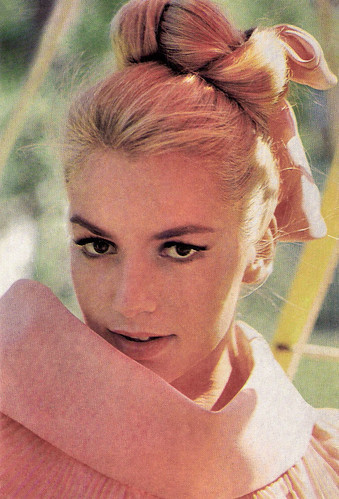
Romanian postcard by Casa Filmului Acin, no. 91.
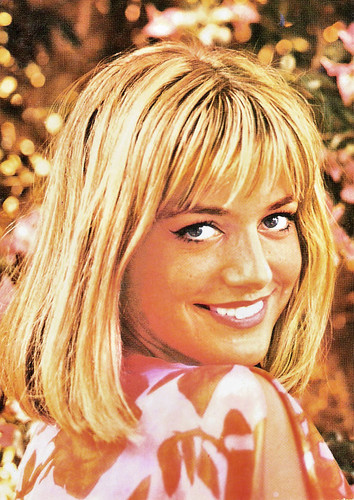
Romanian postcard by Casa Filmului Acin.
The niece of the Belgian prime minister
Catherine Spaak was born in Boulogne-Billancourt, France in 1945. Her father was the Belgian critic and screenwriter Charles Spaak, her mother the actress Claudie Clèves and her sister is actress-photographer Agnès Spaak.
As a teenager, Catherine started her career with small roles in French films like the short L’hiver/The winter (Jacques Gautier, 1959) and the thriller Le Trou/Nightwatch (Jacques Becker, 1960).
When she moved to Italy later that year, her father introduced her to film director Alberto Lattuada, who cast her in his film I dolci inganni/Sweet Deceptions (Alberto Lattuada, 1960). That coming of age film made her a star in Italy. She played a young Roman girl in love, who spends the day observing other lovers' behaviours and considering whether she is ready to jump.
J.C. Mohsen at IMDb : “This film's unpredictability is refreshing. Whether written or filmed, coming-of-age stories often fail to surprise or intrigue the audience. In I Dolci Inganni, most characters seem at first to be crazily entertaining walking clichés, but they later astonish the audience by revealing their depth and their inner struggles.”
From age 15 to 18, Spaak was the lead actress in a dozen films, including La voglia matta/Crazy Desire (Luciano Salce, 1961) opposite Ugo Tognazzi , the classic comedy Il sorpasso/The Easy Life (Dino Risi, 1962) with Vittorio Gassman , La parmigiana/The Girl from Parma (Antonio Pietrangeli, 1963) with Nino Manfredi , and the Alberto Moravia adaptation La noia/The Empty Canvas (Damiano Damiani, 1963) with Horst Buchholz and Bette Davis.
For her performance in La noia she was awarded in 1964 the David di Donatello, the Italian Oscar. Spaak often played the Lolita-type who seduced men, and the Italian scandal press wrote about herself in that way. In their articles, journalists always included that she was the niece of the Belgian prime minister, Paul-Henri Spaak.

Italian postcard by Rotalfoto, Milano, no. 194.
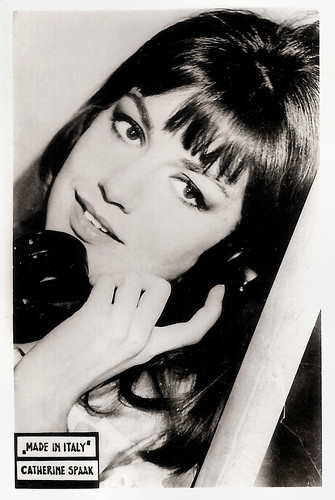
Small Romanian collectors card. Photo: Catherine Spaak in Made in Italy (Nanni Loy, 1965).
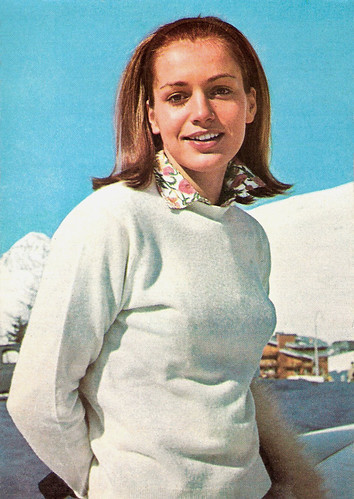
Italian postcard by Edizione diesse.
Some highlights of the Commedia all'Italiana
Catherine Spaak’s screen success, combined with her love of singing and guitar playing, led to an offer of the Ricordi label in 1962. She recorded covers of Françoise Hardy originals and songs in Hardy’s style.
Ready steady girls! , the site on Europe’s fab female singers of the 1960s in their bio: “Perdono – written by Gino Paoli (who had worked with stars such as Mina ) and arranged by Ennio Morricone – was issued as her debut single and swiftly made the Italian top 20. Vocally, Catherine drew comparisons with France’s newest star, Françoise Hardy , so Ricordi opted to have their young signing record a couple of Hardy songs for the Italian market. Issued in 1963, the bilingual Tous les garçons et les filles (Quelli della mia età) – backed with J’ai jeté mon coeur (Ho scherzato con il cuore) – gave Hardy’s original a run for its money, reaching number seven in September 1963 and confirming Catherine as a new star.”
In 1964, she returned to France to appear in La Ronde (Roger Vadim, 1964) and the war drama Week-end à Zuydcoote/Weekend at Dunkirk (Henri Verneuil, 1964) starring Jean-Paul Belmondo .
Back in Italy she played in some more highlights of the Commedia all'Italiana such as L'armata Brancaleone/Brancaleone's Army (Mario Monicelli, 1965) featuring Vittorio Gassman , and Made in Italy (Nanni Loy, 1965).
Other notable appearances include L'uomo dei cinque palloni/Break up (Marco Ferreri, 1965) starring Marcello Mastroianni , and La matriarca/The Libertine (Pasquale Festa Campanile, 1968) with Jean-Louis Trintignant .
In 1967 she went to Hollywood to play Rod Taylor’s love interest in Hotel (Richard Quine, 1967), based on the novel by Arthur Hailey. Hal Erickson at AllMovie : “Once she came to Hollywood, however, Spaak was packaged and promoted as just another foreign starlet, interchangeable with Claudia Cardinale , Camilla Sparv, Elke Sommer and the rest of the batch.”
The result was not a success and soon she was back in Italy. Two years later she did a cameo in another Hollywood production, If It's Tuesday, This Must Be Belgium (Mel Stuart, 1969).
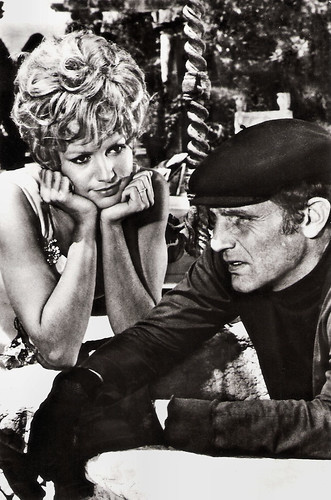
Romanian postcard by Casa Filmului Acin, no. 25. Photo: Catherine Spaak and Philippe Leroy in the crime comedy La notte è fatta per... rubare/Night Is Made for Stealing (Giorgio Capitani, 1968).
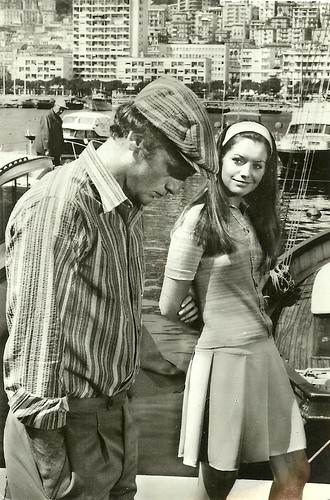
Romanian postcard by Casa Filmului Acin, no. 105. Catherine Spaak and Philippe Leroy in La notte è fatta per... rubare/Night Is Made for Stealing (Giorgio Capitani, 1968), which evolves in Montecarlo.
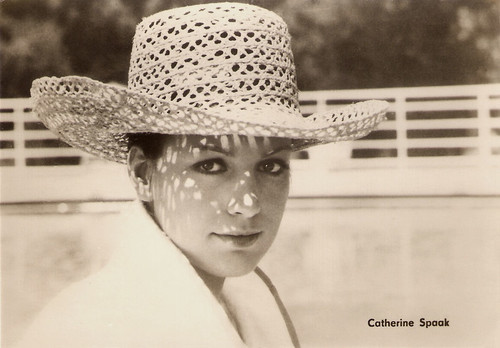
East-German postcard by VEB Progress Film-Vertrieb, Berlin, no. 24/69, 1969. Retail price: 0,20 DM. Photo: Catherine Spaak in La notte è fatta per... rubare /Night Is Made for Stealing (Giorgio Capitani, 1968).
The Cat of Nine Tails
Seeking a new direction, Catherine Spaak joined fellow singer Johnny Dorelli in the operetta 'La vedova allegra' (The Merry Widow) in 1968. The pair went on to enjoy a lasting relationship, both personally and professionally. They enjoyed success as a duo with 'Song sung blue' (1972) and 'Una serata insieme a te' (1973).
During the early 1970s, she continued to appear in many Italian films, but they became less interesting. She starred with Karl Malden and James Franciscus in the Giallo Il gatto a nove code/The Cat o' Nine Tails (Dario Argento, 1971). A reviewer at IMDb call ist "an entertaining and clever thriller that's well worth a look."
In France she made the crime film Un meurtre est un meurtre/A Murder Is a Murder... Is a Murder (Étienne Périer, 1972) with Jean-Claude Brialy . In the American-Italian Western Take a Hard Ride (Antonio Margheriti, 1975), she co-starred with Jim Brown and Lee van Cleef.
From then on, her film appearances became more incidental. In 1978, she had success on stage in the musical 'Cyrano', and would continue to play on stage. She hosted several Italian TV shows such as Forum (1985-1988) and Harem (1989-2002), and wrote articles for newspaper Il corriere della sera and Italian magazines. She also published six books in Italian, such as '26 Donne' (26 women, 1984), 'Un cuore perso' (A lost heart, 1996), 'Lui' (He, 2006) and 'L’amore blu'(Blue Love, 2011).
Her later films include the sex comedy anthology Sunday Lovers (Bryan Forbes, Edouard Molinaro, Dino Risi, Gene Wilder, 1980) as Ugo Tognazzi ’s psychoanalyst, Scandalo Segreto/Secret Scandal (Monica Vitti, 1989) and Tandem (Lucio Pellegrini, 2000) starring the comic duo Luca & Paolo.
More recently she was seen in the film Alice (Oreste Crisostomi, 2009), the BBC mini-series Zen (John Alexander, Jon Jones, Christopher Menaul, 2011) starring Rufus Sewell as detective Aurelio Zen and Spaak as his Mamma, and the film I più' grandi di tutti/The greatest of all (Carlo Virzì, 2012).
Catherine Spaak was married to actor and producer Fabrizio Capucci (1963-1971) and Italian singer-actor Johnny Dorelli (1972-1979). Her present husband is actor Orso Maria Guerrini. With Capucci, she has a daughter, stage actress Sabrina Capucci (1963), and with Dorelli a son, Gabriele Dorelli.
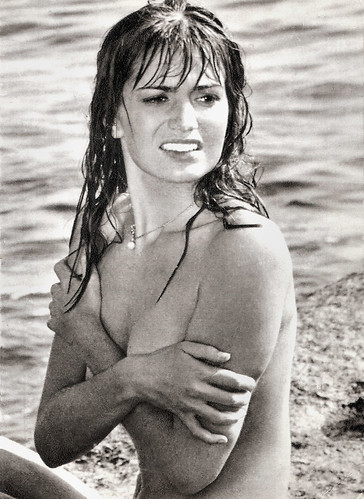
Italian collectors card by La Rotografica Romana. Edito dalla Nat Nuova Alta Tensione.
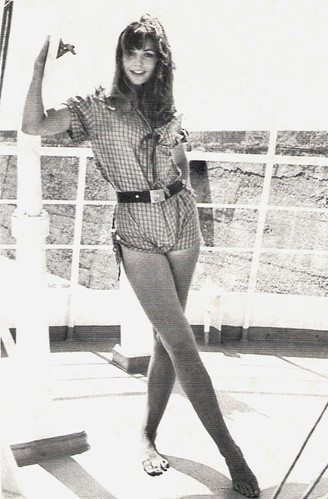
Romanian postcard by Casa Filmului Acin.

Romanian postcard by Casa Filmului Acin.
Sources: Hal Erickson (AllMovie), CatherineSpaak.eu, Ready Steady Girls!, Wikipedia (Italian, French, German and English) and .

Romanian postcard by Casa Filmului Acin, no. 519.

Romanian postcard by Casa Filmului Acin, no. 91.

Romanian postcard by Casa Filmului Acin.
The niece of the Belgian prime minister
Catherine Spaak was born in Boulogne-Billancourt, France in 1945. Her father was the Belgian critic and screenwriter Charles Spaak, her mother the actress Claudie Clèves and her sister is actress-photographer Agnès Spaak.
As a teenager, Catherine started her career with small roles in French films like the short L’hiver/The winter (Jacques Gautier, 1959) and the thriller Le Trou/Nightwatch (Jacques Becker, 1960).
When she moved to Italy later that year, her father introduced her to film director Alberto Lattuada, who cast her in his film I dolci inganni/Sweet Deceptions (Alberto Lattuada, 1960). That coming of age film made her a star in Italy. She played a young Roman girl in love, who spends the day observing other lovers' behaviours and considering whether she is ready to jump.
J.C. Mohsen at IMDb : “This film's unpredictability is refreshing. Whether written or filmed, coming-of-age stories often fail to surprise or intrigue the audience. In I Dolci Inganni, most characters seem at first to be crazily entertaining walking clichés, but they later astonish the audience by revealing their depth and their inner struggles.”
From age 15 to 18, Spaak was the lead actress in a dozen films, including La voglia matta/Crazy Desire (Luciano Salce, 1961) opposite Ugo Tognazzi , the classic comedy Il sorpasso/The Easy Life (Dino Risi, 1962) with Vittorio Gassman , La parmigiana/The Girl from Parma (Antonio Pietrangeli, 1963) with Nino Manfredi , and the Alberto Moravia adaptation La noia/The Empty Canvas (Damiano Damiani, 1963) with Horst Buchholz and Bette Davis.
For her performance in La noia she was awarded in 1964 the David di Donatello, the Italian Oscar. Spaak often played the Lolita-type who seduced men, and the Italian scandal press wrote about herself in that way. In their articles, journalists always included that she was the niece of the Belgian prime minister, Paul-Henri Spaak.

Italian postcard by Rotalfoto, Milano, no. 194.

Small Romanian collectors card. Photo: Catherine Spaak in Made in Italy (Nanni Loy, 1965).

Italian postcard by Edizione diesse.
Some highlights of the Commedia all'Italiana
Catherine Spaak’s screen success, combined with her love of singing and guitar playing, led to an offer of the Ricordi label in 1962. She recorded covers of Françoise Hardy originals and songs in Hardy’s style.
Ready steady girls! , the site on Europe’s fab female singers of the 1960s in their bio: “Perdono – written by Gino Paoli (who had worked with stars such as Mina ) and arranged by Ennio Morricone – was issued as her debut single and swiftly made the Italian top 20. Vocally, Catherine drew comparisons with France’s newest star, Françoise Hardy , so Ricordi opted to have their young signing record a couple of Hardy songs for the Italian market. Issued in 1963, the bilingual Tous les garçons et les filles (Quelli della mia età) – backed with J’ai jeté mon coeur (Ho scherzato con il cuore) – gave Hardy’s original a run for its money, reaching number seven in September 1963 and confirming Catherine as a new star.”
In 1964, she returned to France to appear in La Ronde (Roger Vadim, 1964) and the war drama Week-end à Zuydcoote/Weekend at Dunkirk (Henri Verneuil, 1964) starring Jean-Paul Belmondo .
Back in Italy she played in some more highlights of the Commedia all'Italiana such as L'armata Brancaleone/Brancaleone's Army (Mario Monicelli, 1965) featuring Vittorio Gassman , and Made in Italy (Nanni Loy, 1965).
Other notable appearances include L'uomo dei cinque palloni/Break up (Marco Ferreri, 1965) starring Marcello Mastroianni , and La matriarca/The Libertine (Pasquale Festa Campanile, 1968) with Jean-Louis Trintignant .
In 1967 she went to Hollywood to play Rod Taylor’s love interest in Hotel (Richard Quine, 1967), based on the novel by Arthur Hailey. Hal Erickson at AllMovie : “Once she came to Hollywood, however, Spaak was packaged and promoted as just another foreign starlet, interchangeable with Claudia Cardinale , Camilla Sparv, Elke Sommer and the rest of the batch.”
The result was not a success and soon she was back in Italy. Two years later she did a cameo in another Hollywood production, If It's Tuesday, This Must Be Belgium (Mel Stuart, 1969).

Romanian postcard by Casa Filmului Acin, no. 25. Photo: Catherine Spaak and Philippe Leroy in the crime comedy La notte è fatta per... rubare/Night Is Made for Stealing (Giorgio Capitani, 1968).

Romanian postcard by Casa Filmului Acin, no. 105. Catherine Spaak and Philippe Leroy in La notte è fatta per... rubare/Night Is Made for Stealing (Giorgio Capitani, 1968), which evolves in Montecarlo.

East-German postcard by VEB Progress Film-Vertrieb, Berlin, no. 24/69, 1969. Retail price: 0,20 DM. Photo: Catherine Spaak in La notte è fatta per... rubare /Night Is Made for Stealing (Giorgio Capitani, 1968).
The Cat of Nine Tails
Seeking a new direction, Catherine Spaak joined fellow singer Johnny Dorelli in the operetta 'La vedova allegra' (The Merry Widow) in 1968. The pair went on to enjoy a lasting relationship, both personally and professionally. They enjoyed success as a duo with 'Song sung blue' (1972) and 'Una serata insieme a te' (1973).
During the early 1970s, she continued to appear in many Italian films, but they became less interesting. She starred with Karl Malden and James Franciscus in the Giallo Il gatto a nove code/The Cat o' Nine Tails (Dario Argento, 1971). A reviewer at IMDb call ist "an entertaining and clever thriller that's well worth a look."
In France she made the crime film Un meurtre est un meurtre/A Murder Is a Murder... Is a Murder (Étienne Périer, 1972) with Jean-Claude Brialy . In the American-Italian Western Take a Hard Ride (Antonio Margheriti, 1975), she co-starred with Jim Brown and Lee van Cleef.
From then on, her film appearances became more incidental. In 1978, she had success on stage in the musical 'Cyrano', and would continue to play on stage. She hosted several Italian TV shows such as Forum (1985-1988) and Harem (1989-2002), and wrote articles for newspaper Il corriere della sera and Italian magazines. She also published six books in Italian, such as '26 Donne' (26 women, 1984), 'Un cuore perso' (A lost heart, 1996), 'Lui' (He, 2006) and 'L’amore blu'(Blue Love, 2011).
Her later films include the sex comedy anthology Sunday Lovers (Bryan Forbes, Edouard Molinaro, Dino Risi, Gene Wilder, 1980) as Ugo Tognazzi ’s psychoanalyst, Scandalo Segreto/Secret Scandal (Monica Vitti, 1989) and Tandem (Lucio Pellegrini, 2000) starring the comic duo Luca & Paolo.
More recently she was seen in the film Alice (Oreste Crisostomi, 2009), the BBC mini-series Zen (John Alexander, Jon Jones, Christopher Menaul, 2011) starring Rufus Sewell as detective Aurelio Zen and Spaak as his Mamma, and the film I più' grandi di tutti/The greatest of all (Carlo Virzì, 2012).
Catherine Spaak was married to actor and producer Fabrizio Capucci (1963-1971) and Italian singer-actor Johnny Dorelli (1972-1979). Her present husband is actor Orso Maria Guerrini. With Capucci, she has a daughter, stage actress Sabrina Capucci (1963), and with Dorelli a son, Gabriele Dorelli.

Italian collectors card by La Rotografica Romana. Edito dalla Nat Nuova Alta Tensione.

Romanian postcard by Casa Filmului Acin.

Romanian postcard by Casa Filmului Acin.
Sources: Hal Erickson (AllMovie), CatherineSpaak.eu, Ready Steady Girls!, Wikipedia (Italian, French, German and English) and .
Published on June 24, 2019 22:00
June 23, 2019
Jack Nicholson
In the section 'Recovered and Restored', Cinema Ritrovato presents Five Easy Pieces (1970) by Bob Rafelson. It is one of my favourite Jack Nicholson films. He became my hero when I saw him in One Flew Over the Cuckoo's Nest (1975) during high school. In both films he was the guy who rebels against the social structure. Since then he played countless anti-heroes and villains. Although Nicholson has performed in films for over sixty years now and received 12 (yes twelve!) Oscar nominations, I still have a soft spot for these two films he made in the first half of the 1970s.
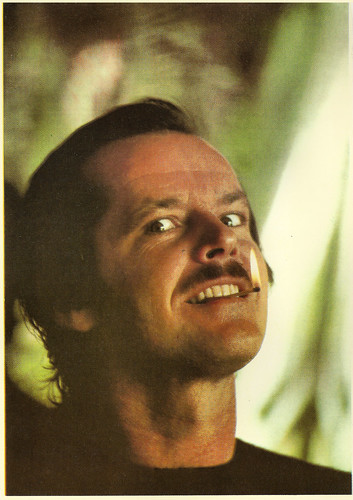
French postcard in the Collection Cinéma Couleur by Editions Le Malibran, Paris, 1989, no. MC 24. Photo: Douglas Kirkland. Caption: Jack Nicholson (1973).
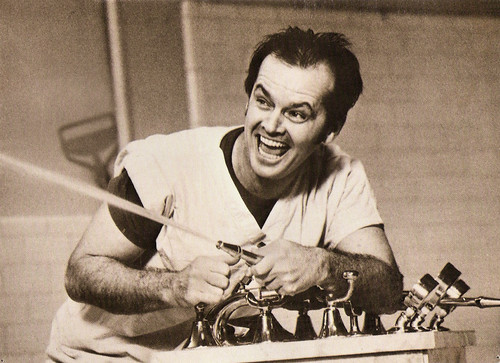
Spanish postcard by Foto Parjetas, Madrid, no. FC-225. Photo: Jack Nicholson in One Flew Over the Cuckoo's Nest (Miloš Forman, 1975).
Class Clown of 1954
Jack Nicholson was born in 1937 as John Joseph Nicholson in Neptune City, New Jersey. He was the son of a showgirl, June Frances Nicholson (stage name June Nilson). She married Italian-American showman Donald Furcillo (stage name Donald Rose) in 1936, before realising that he was already married.
Biographer Patrick McGilligan stated in his book 'Jack's Life' that Latvian-born Eddie King, June's manager, may have been Nicholson's biological father, rather than Furcillo. Other sources suggest June Nicholson was unsure of who the father was. As June was only seventeen years old and unmarried, her parents agreed to raise Nicholson as their own child without revealing his true parentage, and June would act as his sister.
In 1974, Time magazine researchers learned, and informed Nicholson, that his 'sister', June, was actually his mother, and his other 'sister', Lorraine, was really his aunt. By this time, both his mother and grandmother had died (in 1963 and 1970, respectively). On finding out, Nicholson said it was "a pretty dramatic event, but it wasn't what I'd call traumatizing ... I was pretty well psychologically formed".
Before starting high school, his family moved to an apartment in Spring Lake, New Jersey. When Jack was ready for high school, the family moved once more, to old-money Spring Lake, New Jersey's so-called Irish Riviera, where Ethel May set up her beauty parlour. 'Nick', as he was known to his high school friends, attended nearby Manasquan High School, where he was voted 'Class Clown' by the Class of 1954.
In 1957, Nicholson joined the California Air National Guard. After completing the Air Force's basic training, Nicholson performed weekend drills and two-week annual training as a fire fighter. Nicholson first came to Hollywood in 1954, when he was seventeen, to visit his sister. He took a job as an office worker for animators William Hanna and Joseph Barbera at the MGM cartoon studio.
He trained to be an actor with a group called the Players Ring Theater, after which time he found small parts performing on the stage and in TV soap operas. He made his film debut in a low-budget teen drama The Cry Baby Killer (Justus Addiss, 1958), playing the title role. For the following decade, Nicholson was a frequent collaborator with the film's producer, Roger Corman. Corman directed Nicholson on several occasions, most notably in The Little Shop of Horrors (Roger Corman, 1960), as masochistic dental patient and undertaker Wilbur Force, and also in The Raven (Roger Corman, 1963), The Terror (Roger Corman, 1963) as a French officer seduced by an evil ghost, and The St. Valentine's Day Massacre (Roger Corman, 1967).
Nicholson also frequently worked with director Monte Hellman on low-budget Westerns, including the cult successes Ride in the Whirlwind (Monte Hellman, 1966) with Cameron Mitchell, and The Shooting (Monte Hellman, 1966) opposite Millie Perkins. Nicholson also appeared in episodes of TV series like Dr. Kildare (1966) and The Andy Griffith Show (1966-1967).
However, Nicholson seemed resigned to a career behind the camera as a writer/director. His first real taste of writing success was the screenplay for the counterculture film The Trip (Roger Corman, 1967), which starred Peter Fonda and Dennis Hopper. Nicholson also co-wrote, with Bob Rafelson, Head (Bob Rafelson, 1968), which starred The Monkees . He also arranged the film's soundtrack. Nicholson's first turn in the director's chair was for Drive, He Said (1971).
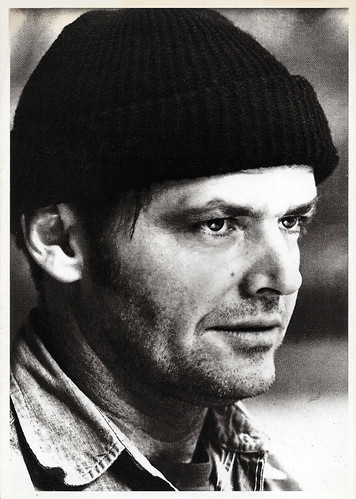
French postcard by Especially for you, no. Réf. 39. Photo: Jack Nicholson in One Flew Over the Cuckoo's Nest (Miloš Forman, 1975).
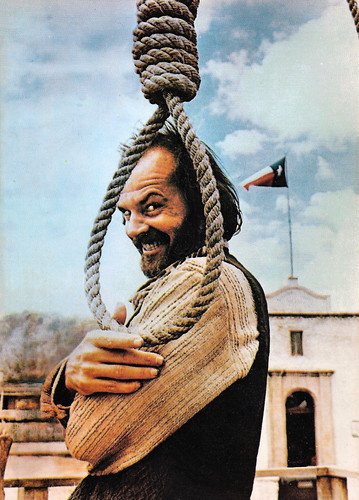
French postcard by Edition Librairie Images 'In', no. H 18. Photo: Jack Nicholson in Goin' South (Jack Nicholson, 1978).
A hero of the counter-culture movement
Jack Nicholson had his acting break when a spot opened up in Easy Rider (Dennis Hopper, 1969). Nicholson played liquor-soaked lawyer George Hanson, for which he received his first Oscar nomination. The film cost only $400,000 to make, and became a blockbuster, grossing $40 million. Overnight, Nicholson became a hero of the counter-culture movement.
Nicholson was cast by Stanley Kubrick, who was impressed with his role in Easy Rider, in the part of Napoleon in a film about his life, and although production on the film commenced, the project fizzled out, partly due to a change in ownership at MGM.
Nicholson starred in Five Easy Pieces (Bob Rafelson, 1970) alongside Karen Black. Bobby Dupea, an oil rig worker, became his persona-defining role. Nicholson and Black were nominated for Academy Awards for their performances. Critics began speculating whether he might become another Marlon Brando or James Dean .
His career and income skyrocketed. Nicholson starred in Carnal Knowledge (Mike Nichols, 1971), which co-starred Art Garfunkel, Ann-Margret , and Candice Bergen. Other roles included Billy 'Bad Ass' Buddusky in The Last Detail (Hal Ashby, 1973). For his role, Nicholson won the Best Actor award at the Cannes Film Festival, and he was nominated for his third Oscar and a Golden Globe.
In 1974, Nicholson starred in Roman Polanski's majestic Film Noir Chinatown, opposite Faye Dunaway. For his role as private detective Jake Gittes, he was again nominated for Academy Award for Best Actor. The role was a major transition from the exploitation films of the previous decade.
One of Nicholson's greatest successes came with his role as Randle P. McMurphy in One Flew Over the Cuckoo's Nest (Miloš Forman, 1975). It was an adaptation of Ken Kesey's novel, and co-produced by Michael Douglas. Nicholson plays an anti-authoritarian patient at a mental hospital where he becomes an inspiring leader for the other patients. The film swept the Academy Awards with nine nominations, and won the top five, including Nicholson's first for Best Actor.
Also in that year, Nicholson starred in Michelangelo Antonioni's The Passenger (1975), which co-starred Maria Schneider. The film received good reviews and revived Antonioni's reputation as one of cinema's great directors. Nicholson took a small role in The Last Tycoon (Elia Kazan, 1976), opposite Robert De Niro . He took a less sympathetic role in Arthur Penn's Western The Missouri Breaks (1976), specifically to work with Marlon Brando .
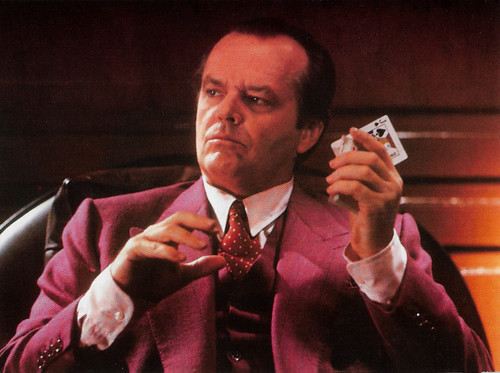
British postcard by Athena International, Bat, no. 11, 1989, no. 0334341. Photo: DC Comics Inc. Jack Nicholson in Batman (Tim Burton, 1989).
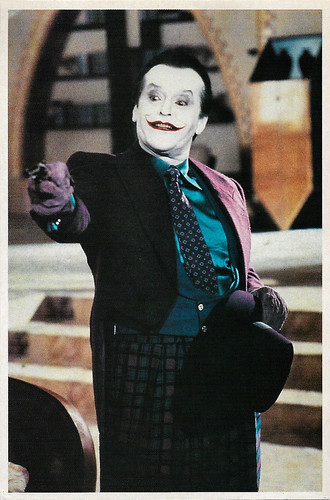
French postcard by Editions Mercuri, no. 87. Photo: Jack Nicholson in Batman (Tim Burton, 1989).
The Joker
Although Jack Nicholson did not win an Oscar for Stanley Kubrick's adaptation of Stephen King's The Shining (1980), it remains one of his more significant roles. Nicholson improvised his now famous "Here's Johnny!" line, along with the scene in which he's sitting at the typewriter and unleashes his anger upon his wife after she discovers he has gone insane when she looks at his writing ("all work and no play makes Jack a dull boy" typed endlessly).
In 1982, he starred as an immigration enforcement agent in The Border (Tony Richardson, 1982, co-starring Warren Oates. Nicholson won his second Oscar, an Academy Award for Best Supporting Actor, for his role of retired astronaut Garrett Breedlove in Terms of Endearment (James L. Brooks, 1983), starring Shirley MacLaine and Debra Winger. He and MacLaine played many of their scenes in different ways, constantly testing and making adjustments.
Nicholson continued to work prolifically in the 1980s, starring in such films as The Postman Always Rings Twice (Bob Rafelson, 1981), Reds (Warren Beatty, 1981), where Nicholson portrays the writer Eugene O'Neill with a quiet intensity, Prizzi's Honor (John Huston, 1985), The Witches of Eastwick (George Miller, 1987), Broadcast News (James L. Brooks, 1987), and Ironweed (Hector Babenco, 1987) with Meryl Streep. Three Oscar nominations also followed, for Reds, Prizzi's Honor, and Ironweed.
In Batman (Tim Burton, 1989), Nicholson played the psychotic murderer and villain, the Joker. Batman creator Bob Kane personally recommended him for the role. The film was an international smash hit, and a lucrative percentage deal earned him a percentage of the box office gross estimated at $60 million to $90 million.
For his role as hot-headed Col. Nathan R. Jessup in A Few Good Men (Rob Reiner, 1992), a film about a murder in a U.S. Marine Corps unit, Nicholson received yet another Oscar nomination for Best Supporting Actor. In 1996, Nicholson collaborated once more with Batman director Tim Burton on Mars Attacks!, pulling double duty as two contrasting characters, President James Dale and Las Vegas property developer Art Land. At first, studio executives at Warner Bros. disliked the idea of killing off Nicholson's character, so Burton created two characters and killed them both off.
Not all of Nicholson's performances have been well received. He was nominated for Razzie Awards as worst actor for Man Trouble (Bob Rafelson, 1992) and Hoffa (Danny DeVito, 1992). However, Nicholson's performance in Hoffa also earned him a Golden Globe nomination.
Nicholson went on to win his next Academy Award for Best Actor in the romantic comedy As Good as It Gets (1997), his third film directed by James L. Brooks. He played Melvin Udall, a wickedly funny, mean-spirited, obsessive-compulsive novelist. His Oscar was matched with the Academy Award for Best Actress for Helen Hunt, who played a Manhattan wisecracking, single-mother waitress drawn into a love/hate friendship with Udall, a frequent diner in the restaurant. The film was a impressive box office success, grossing $314 million, which made it Nicholson's second-best-grossing film of his career, after Batman.
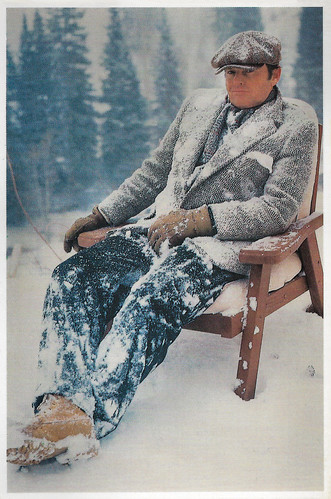
British postcard by World Postcards, no. X253, 1989. Photo: Albert Watson, 1981. Caption: Jack Nicholson, Snow.
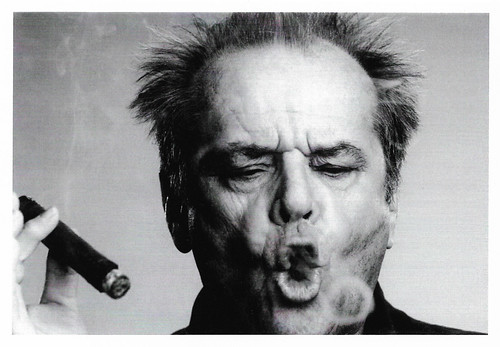
French postcard. Caption: Jack Nicholson luminant un cigare
A return to the dark side
In About Schmidt (Alexander Payne, 2002), Nicholson portrayed a retired Omaha, Nebraska, actuary who questions his own life following his wife's death. His quietly restrained performance earned him another Oscar Nomination. In Anger Management (Peter Segal, 2003), he played an aggressive therapist assigned to help an over pacifist man (Adam Sandler).
In 2003, Nicholson also starred in Something's Gotta Give (Nancy Meyers, 2003), as an ageing playboy who falls for the mother (Diane Keaton) of his young girlfriend.
In late 2006, Nicholson marked his return to the dark side as Frank Costello, a nefarious Boston Irish Mob boss, based on Whitey Bulger who was still on the run at that time, presiding over Matt Damon and Leonardo DiCaprio in Martin Scorsese's Oscar-winning film The Departed, a remake of Andrew Lau's Mou gaan dou/Infernal Affairs (2002). The role earned Nicholson worldwide critical praise, along with various award wins and nominations, including a Golden Globe nomination.
In 2007, Nicholson co-starred with Morgan Freeman in The Bucket List (Rob Reiner, 2007). Nicholson and Freeman portrayed dying men who fulfil their list of goals. Nicholson reunited with James L. Brooks, director of Terms of Endearment, Broadcast News, and As Good as It Gets, for a supporting role as Paul Rudd's character's father in How Do You Know (2012).
It had been widely reported in subsequent years that Nicholson had retired from acting because of memory loss, but in a September 2013 Vanity Fair article, Nicholson clarified that he did not consider himself retired, merely that he was now less driven to "be out there any more". In 2015, Nicholson made a special appearance as a presenter on SNL 40, the 40th anniversary special of Saturday Night Live.
After the death of boxer Muhammad Ali in 2016, Nicholson appeared on HBO's The Fight Game with Jim Lampley for an exclusive interview about his friendship with Ali. In 2017, it was reported that Nicholson would be starring in an English-language remake of Toni Erdmann (Maren Ade, 2016) opposite Kristen Wiig, but Nicholson dropped out of the project.
Jack Nicholson has also directed three films, including The Two Jakes (1990), the sequel to Chinatown. Nicholson is one of three male actors to win three Academy Awards. He also has won six Golden Globe Awards.
He has had a number of high-profile relationships, and was married to actress Sandra Knight from 1962 until their divorce in 1968. Nicholson has five children. His eldest daughter is Jennifer Nicholson (1963), from his marriage to Knight. He has a son, Caleb James Goddard (1970) with actress Susan Anspach, and a daughter, Honey Hollman (1981) with Danish supermodel Winnie Hollman. With Rebecca Broussard, he has two children, Lorraine Nicholson (1990) and Ray Nicholson (1992). Nicholson's longest relationship was the 17 years he spent with actress Anjelica Huston; this ended when Broussard become pregnant with his child.
Jack Nicholson is the only actor to ever play the Devil, the Joker, and a werewolf.
Trailer Five Easy Pieces (Bob Rafelson, 1970). Source: ryy79 (YouTube).
Sources: (IMDb), Wikipedia and .

French postcard in the Collection Cinéma Couleur by Editions Le Malibran, Paris, 1989, no. MC 24. Photo: Douglas Kirkland. Caption: Jack Nicholson (1973).

Spanish postcard by Foto Parjetas, Madrid, no. FC-225. Photo: Jack Nicholson in One Flew Over the Cuckoo's Nest (Miloš Forman, 1975).
Class Clown of 1954
Jack Nicholson was born in 1937 as John Joseph Nicholson in Neptune City, New Jersey. He was the son of a showgirl, June Frances Nicholson (stage name June Nilson). She married Italian-American showman Donald Furcillo (stage name Donald Rose) in 1936, before realising that he was already married.
Biographer Patrick McGilligan stated in his book 'Jack's Life' that Latvian-born Eddie King, June's manager, may have been Nicholson's biological father, rather than Furcillo. Other sources suggest June Nicholson was unsure of who the father was. As June was only seventeen years old and unmarried, her parents agreed to raise Nicholson as their own child without revealing his true parentage, and June would act as his sister.
In 1974, Time magazine researchers learned, and informed Nicholson, that his 'sister', June, was actually his mother, and his other 'sister', Lorraine, was really his aunt. By this time, both his mother and grandmother had died (in 1963 and 1970, respectively). On finding out, Nicholson said it was "a pretty dramatic event, but it wasn't what I'd call traumatizing ... I was pretty well psychologically formed".
Before starting high school, his family moved to an apartment in Spring Lake, New Jersey. When Jack was ready for high school, the family moved once more, to old-money Spring Lake, New Jersey's so-called Irish Riviera, where Ethel May set up her beauty parlour. 'Nick', as he was known to his high school friends, attended nearby Manasquan High School, where he was voted 'Class Clown' by the Class of 1954.
In 1957, Nicholson joined the California Air National Guard. After completing the Air Force's basic training, Nicholson performed weekend drills and two-week annual training as a fire fighter. Nicholson first came to Hollywood in 1954, when he was seventeen, to visit his sister. He took a job as an office worker for animators William Hanna and Joseph Barbera at the MGM cartoon studio.
He trained to be an actor with a group called the Players Ring Theater, after which time he found small parts performing on the stage and in TV soap operas. He made his film debut in a low-budget teen drama The Cry Baby Killer (Justus Addiss, 1958), playing the title role. For the following decade, Nicholson was a frequent collaborator with the film's producer, Roger Corman. Corman directed Nicholson on several occasions, most notably in The Little Shop of Horrors (Roger Corman, 1960), as masochistic dental patient and undertaker Wilbur Force, and also in The Raven (Roger Corman, 1963), The Terror (Roger Corman, 1963) as a French officer seduced by an evil ghost, and The St. Valentine's Day Massacre (Roger Corman, 1967).
Nicholson also frequently worked with director Monte Hellman on low-budget Westerns, including the cult successes Ride in the Whirlwind (Monte Hellman, 1966) with Cameron Mitchell, and The Shooting (Monte Hellman, 1966) opposite Millie Perkins. Nicholson also appeared in episodes of TV series like Dr. Kildare (1966) and The Andy Griffith Show (1966-1967).
However, Nicholson seemed resigned to a career behind the camera as a writer/director. His first real taste of writing success was the screenplay for the counterculture film The Trip (Roger Corman, 1967), which starred Peter Fonda and Dennis Hopper. Nicholson also co-wrote, with Bob Rafelson, Head (Bob Rafelson, 1968), which starred The Monkees . He also arranged the film's soundtrack. Nicholson's first turn in the director's chair was for Drive, He Said (1971).

French postcard by Especially for you, no. Réf. 39. Photo: Jack Nicholson in One Flew Over the Cuckoo's Nest (Miloš Forman, 1975).

French postcard by Edition Librairie Images 'In', no. H 18. Photo: Jack Nicholson in Goin' South (Jack Nicholson, 1978).
A hero of the counter-culture movement
Jack Nicholson had his acting break when a spot opened up in Easy Rider (Dennis Hopper, 1969). Nicholson played liquor-soaked lawyer George Hanson, for which he received his first Oscar nomination. The film cost only $400,000 to make, and became a blockbuster, grossing $40 million. Overnight, Nicholson became a hero of the counter-culture movement.
Nicholson was cast by Stanley Kubrick, who was impressed with his role in Easy Rider, in the part of Napoleon in a film about his life, and although production on the film commenced, the project fizzled out, partly due to a change in ownership at MGM.
Nicholson starred in Five Easy Pieces (Bob Rafelson, 1970) alongside Karen Black. Bobby Dupea, an oil rig worker, became his persona-defining role. Nicholson and Black were nominated for Academy Awards for their performances. Critics began speculating whether he might become another Marlon Brando or James Dean .
His career and income skyrocketed. Nicholson starred in Carnal Knowledge (Mike Nichols, 1971), which co-starred Art Garfunkel, Ann-Margret , and Candice Bergen. Other roles included Billy 'Bad Ass' Buddusky in The Last Detail (Hal Ashby, 1973). For his role, Nicholson won the Best Actor award at the Cannes Film Festival, and he was nominated for his third Oscar and a Golden Globe.
In 1974, Nicholson starred in Roman Polanski's majestic Film Noir Chinatown, opposite Faye Dunaway. For his role as private detective Jake Gittes, he was again nominated for Academy Award for Best Actor. The role was a major transition from the exploitation films of the previous decade.
One of Nicholson's greatest successes came with his role as Randle P. McMurphy in One Flew Over the Cuckoo's Nest (Miloš Forman, 1975). It was an adaptation of Ken Kesey's novel, and co-produced by Michael Douglas. Nicholson plays an anti-authoritarian patient at a mental hospital where he becomes an inspiring leader for the other patients. The film swept the Academy Awards with nine nominations, and won the top five, including Nicholson's first for Best Actor.
Also in that year, Nicholson starred in Michelangelo Antonioni's The Passenger (1975), which co-starred Maria Schneider. The film received good reviews and revived Antonioni's reputation as one of cinema's great directors. Nicholson took a small role in The Last Tycoon (Elia Kazan, 1976), opposite Robert De Niro . He took a less sympathetic role in Arthur Penn's Western The Missouri Breaks (1976), specifically to work with Marlon Brando .

British postcard by Athena International, Bat, no. 11, 1989, no. 0334341. Photo: DC Comics Inc. Jack Nicholson in Batman (Tim Burton, 1989).

French postcard by Editions Mercuri, no. 87. Photo: Jack Nicholson in Batman (Tim Burton, 1989).
The Joker
Although Jack Nicholson did not win an Oscar for Stanley Kubrick's adaptation of Stephen King's The Shining (1980), it remains one of his more significant roles. Nicholson improvised his now famous "Here's Johnny!" line, along with the scene in which he's sitting at the typewriter and unleashes his anger upon his wife after she discovers he has gone insane when she looks at his writing ("all work and no play makes Jack a dull boy" typed endlessly).
In 1982, he starred as an immigration enforcement agent in The Border (Tony Richardson, 1982, co-starring Warren Oates. Nicholson won his second Oscar, an Academy Award for Best Supporting Actor, for his role of retired astronaut Garrett Breedlove in Terms of Endearment (James L. Brooks, 1983), starring Shirley MacLaine and Debra Winger. He and MacLaine played many of their scenes in different ways, constantly testing and making adjustments.
Nicholson continued to work prolifically in the 1980s, starring in such films as The Postman Always Rings Twice (Bob Rafelson, 1981), Reds (Warren Beatty, 1981), where Nicholson portrays the writer Eugene O'Neill with a quiet intensity, Prizzi's Honor (John Huston, 1985), The Witches of Eastwick (George Miller, 1987), Broadcast News (James L. Brooks, 1987), and Ironweed (Hector Babenco, 1987) with Meryl Streep. Three Oscar nominations also followed, for Reds, Prizzi's Honor, and Ironweed.
In Batman (Tim Burton, 1989), Nicholson played the psychotic murderer and villain, the Joker. Batman creator Bob Kane personally recommended him for the role. The film was an international smash hit, and a lucrative percentage deal earned him a percentage of the box office gross estimated at $60 million to $90 million.
For his role as hot-headed Col. Nathan R. Jessup in A Few Good Men (Rob Reiner, 1992), a film about a murder in a U.S. Marine Corps unit, Nicholson received yet another Oscar nomination for Best Supporting Actor. In 1996, Nicholson collaborated once more with Batman director Tim Burton on Mars Attacks!, pulling double duty as two contrasting characters, President James Dale and Las Vegas property developer Art Land. At first, studio executives at Warner Bros. disliked the idea of killing off Nicholson's character, so Burton created two characters and killed them both off.
Not all of Nicholson's performances have been well received. He was nominated for Razzie Awards as worst actor for Man Trouble (Bob Rafelson, 1992) and Hoffa (Danny DeVito, 1992). However, Nicholson's performance in Hoffa also earned him a Golden Globe nomination.
Nicholson went on to win his next Academy Award for Best Actor in the romantic comedy As Good as It Gets (1997), his third film directed by James L. Brooks. He played Melvin Udall, a wickedly funny, mean-spirited, obsessive-compulsive novelist. His Oscar was matched with the Academy Award for Best Actress for Helen Hunt, who played a Manhattan wisecracking, single-mother waitress drawn into a love/hate friendship with Udall, a frequent diner in the restaurant. The film was a impressive box office success, grossing $314 million, which made it Nicholson's second-best-grossing film of his career, after Batman.

British postcard by World Postcards, no. X253, 1989. Photo: Albert Watson, 1981. Caption: Jack Nicholson, Snow.

French postcard. Caption: Jack Nicholson luminant un cigare
A return to the dark side
In About Schmidt (Alexander Payne, 2002), Nicholson portrayed a retired Omaha, Nebraska, actuary who questions his own life following his wife's death. His quietly restrained performance earned him another Oscar Nomination. In Anger Management (Peter Segal, 2003), he played an aggressive therapist assigned to help an over pacifist man (Adam Sandler).
In 2003, Nicholson also starred in Something's Gotta Give (Nancy Meyers, 2003), as an ageing playboy who falls for the mother (Diane Keaton) of his young girlfriend.
In late 2006, Nicholson marked his return to the dark side as Frank Costello, a nefarious Boston Irish Mob boss, based on Whitey Bulger who was still on the run at that time, presiding over Matt Damon and Leonardo DiCaprio in Martin Scorsese's Oscar-winning film The Departed, a remake of Andrew Lau's Mou gaan dou/Infernal Affairs (2002). The role earned Nicholson worldwide critical praise, along with various award wins and nominations, including a Golden Globe nomination.
In 2007, Nicholson co-starred with Morgan Freeman in The Bucket List (Rob Reiner, 2007). Nicholson and Freeman portrayed dying men who fulfil their list of goals. Nicholson reunited with James L. Brooks, director of Terms of Endearment, Broadcast News, and As Good as It Gets, for a supporting role as Paul Rudd's character's father in How Do You Know (2012).
It had been widely reported in subsequent years that Nicholson had retired from acting because of memory loss, but in a September 2013 Vanity Fair article, Nicholson clarified that he did not consider himself retired, merely that he was now less driven to "be out there any more". In 2015, Nicholson made a special appearance as a presenter on SNL 40, the 40th anniversary special of Saturday Night Live.
After the death of boxer Muhammad Ali in 2016, Nicholson appeared on HBO's The Fight Game with Jim Lampley for an exclusive interview about his friendship with Ali. In 2017, it was reported that Nicholson would be starring in an English-language remake of Toni Erdmann (Maren Ade, 2016) opposite Kristen Wiig, but Nicholson dropped out of the project.
Jack Nicholson has also directed three films, including The Two Jakes (1990), the sequel to Chinatown. Nicholson is one of three male actors to win three Academy Awards. He also has won six Golden Globe Awards.
He has had a number of high-profile relationships, and was married to actress Sandra Knight from 1962 until their divorce in 1968. Nicholson has five children. His eldest daughter is Jennifer Nicholson (1963), from his marriage to Knight. He has a son, Caleb James Goddard (1970) with actress Susan Anspach, and a daughter, Honey Hollman (1981) with Danish supermodel Winnie Hollman. With Rebecca Broussard, he has two children, Lorraine Nicholson (1990) and Ray Nicholson (1992). Nicholson's longest relationship was the 17 years he spent with actress Anjelica Huston; this ended when Broussard become pregnant with his child.
Jack Nicholson is the only actor to ever play the Devil, the Joker, and a werewolf.
Trailer Five Easy Pieces (Bob Rafelson, 1970). Source: ryy79 (YouTube).
Sources: (IMDb), Wikipedia and .
Published on June 23, 2019 22:00
June 22, 2019
Jean Gabin, The Man With The Blue Eyes
We're in Bologna, Italy, and like every year, EFSP follows Cinema Ritrovato! One of the programmes is 'Jean Gabin, The Man With The Blue Eyes', which offers only nine out of his ninety-five performances on film, leaving out such masterpieces as La Grande illusion or Le Jour se lève which have been shown at previous editions of the festival. Jean Gabin (1904-1976) was one of the greatest stars of the European cinema. In the 1930s he became the the tragic rebel of the poetic realist film, a kind of James Dean avant la lettre. After the war Gabin was reborn as a tough anti-hero, set in his beliefs, feared and respected by all, the John Wayne of French cinema. Cinema Ritrovato shows some rarities such as Anatole Litvak’s Coeur de lilas and G.W. Pabst’s Du haut en bas, as well as forgotten works such René Clément’s Au-delà des grilles, Marcel Carné’s La Marie du port and films in which he partners with Brigitte Bardot and Simone Signoret, not to mention an inimitable performance as Georges Simenon’s Maigret.
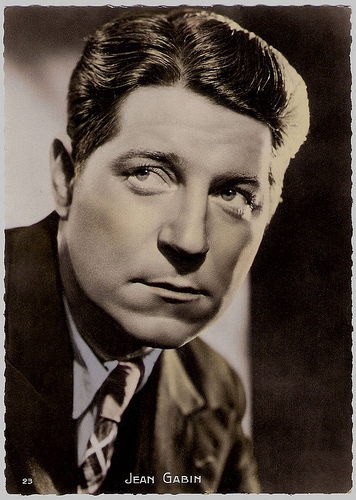
French postcard by Editions P.I., Paris, no. 23.

French postcard by Editions O.P., Paris, no. 29. Photo: Star. Publicity still for Gueule d'amour/Madeleine (Jean Grémillon, 1937).

French postcard by A.N., Paris, no. 1160. Photo: Films Osso. Publicity still for Le quai des brumes/Port of Shadows (Marcel Carne, 1938).
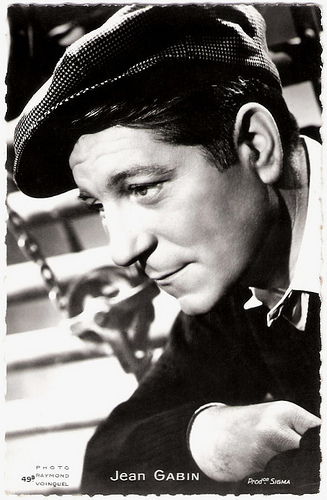
French postcard by Edit. Chantal, Rueil (S.-O.), no, 49B. Photo: Raymond Voinquel / Sigma. Publicity still for Le jour se lève/Daybreak (Marcel Carne, 1939).
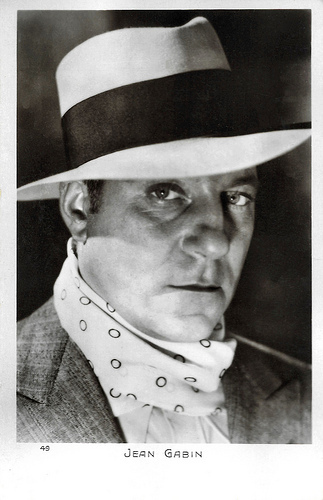
French postcard by Edition Chantal, Paris, no. 49.

French collectors card by Massilia.
From Bottom To Top
Jean Gabin was born Jean-Alexis Gabin Moncorgé in Paris, in 1904. He grew up in the village of Mériel in the Seine-et-Oise département, about 35 km north of Paris. His parents, Ferdinand Moncorgé and Hélène Petit, were entertainers, who performed in local cafés.
Jean worked as a labourer, but from an early age, entertainment was in his blood. At 18, he took a turn at the Folies-Bergère. He then appeared in revues and operettas, singing and dancing, and becoming famous for his imitation of Maurice Chevalier .
Through a chance meeting with the singer Mistinguett in 1928, he was given a spot at the Moulin-Rouge. This led to uncredited parts in two silent sketch films Ohé! Les valises/Hey! Suitcases (1928) and Les Lions/The Lions (1928) with the comic Raymond Dandy.
Two years later, he easily made the transition to sound film in the Pathé Frères production Chacun sa Chance/Everyone a chance (René Pujol, Hans Steinhoff, 1930). In this film he appeared with Gaby Basset, whom he had married in 1927.
Gabin made more than a dozen films over the next four years, including Méphisto (Henri Debain, Georges Vinter, 1930), Tout ça ne vaut pas l'amour/While it's not worth the love (Jacques Tourneur, 1931), Coeur de lilas/Lilac (Anatole Litvak, 1932), Les gaietés de l'escadron/Fun in Barracks (Maurice Tourneur, 1932), La Foule hurle (John Daumery, Howard Hawks, 1932) and Du haut en bas/From Top to Bottom (Georg Wilhelm Pabst, 1933).
He gained real recognition for his performance in Maria Chapdelaine (Julien Duvivier, 1934) starring Madeleine Renaud . Cast as a romantic hero opposite Annabella in the war drama La Bandera/Escape from Yesterday (Julien Duvivier, 1936) established Gabin as a major star.
He teamed up with Julien Duvivier again, this time in La belle équipe/They Were Five (1936) and in the highly successful Pépé le Moko (1937) that became one of the top grossing films of 1937 worldwide. Its popularity brought Gabin international recognition.
That same year, he starred in the masterpiece La grande Illusion/The Grand Illusion (Jean Renoir, 1937) an anti-war film that was a huge box office success and given universal critical acclaim, even running at a New York City theatre for an unprecedented six months.
This was followed by another one of Renoir's great successes: La bête humaine/The Human Beast (Jean Renoir, 1938), a Film Noir tragedy based on the novel by Émile Zola and starring Gabin and Simone Simon , as well as Le quai des brumes/Port of Shadows (1938) and Le jour se lève/Daybreak (1939) with Arletty , two of director Marcel Carné's most acclaimed films.

French postcard by A.N., Paris, no. 692. Photo: Film Pathé-Natan. Publicity still for Chacun sa chance/Everyone a chance (René Pujol, Hans Steinhoff, 1930).

French postcard by Edition Chantal, Paris, no. 49. Photo: Pathé-Consortium.

French postcard, no. 49. Photo: publicity still for La Bandera (Julien Duvivier, 1935).

French postcard by Erpé, no. 567. Photo: Film ACE, Paris. Publicity still for Gueule d'amour/Madeleine (Jean Grémillon, 1937).

French postcard by Crépa, Editeur, Paris. Photo: Sam Lévin. Publicity still for La grande illusion/The Grand Illusion (Jean Renoir, 1937) with Jean Gabin, Dalio , Julien Carette, Gaston Modot and Pierre Fresnay .
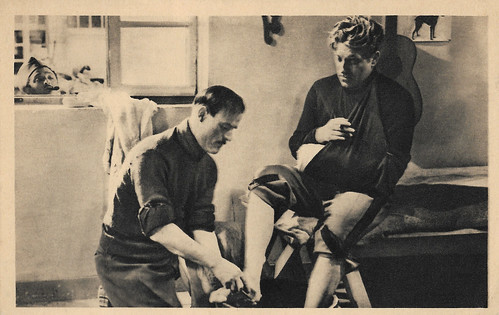
French postcard by Crépa, Editeur, Paris. Photo: Sam Lévin / Production R.A.C. Marcel Dalio , Gaston Modot and Jean Gabin in La grande illusion/The Grand Illusion (Jean Renoir, 1937).

French postcard by Edit. Chantal, Rueil, no. 49B.

French postcard by Viny, no. 12. Photo: Paris Film.
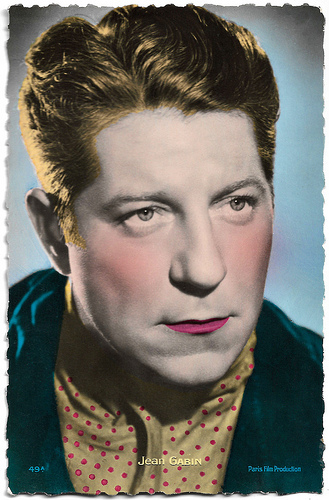
French postcard by edition Chantal, Paris, no. 49A. Photo: Paris Film Production.
Marlene
Jean Gabin was flooded with offers from Hollywood. For a time he turned them all down until the outbreak of World War II. Following the German occupation of France, he joined Jean Renoir and Julien Duvivier in the United States.
He had divorced his second wife Suzanne Mauchain in 1939, and during his time in Hollywood, Gabin began a torrid romance with film star Marlene Dietrich .
His Hollywood film career proved to be less successful: he made two films, Moon Tide (Archie Mayo, 1942) and The Impostor (Julien Duvivier, 1944), both of which were flops. Scheduled to star in an RKO film, at the last minute he demanded Dietrich be given the co-starring role. The studio refused. After Gabin remained steadfast in his demand, he was fired, and the film project was shelved.
Undaunted, he enlisted in 1943 as a tank commander in the Forces françaises libres. He earned the Médaille Militaire and a Croix de Guerre for his wartime valour fighting with the Allies in North Africa. Following D-Day, Gabin was part of the military contingent that entered a liberated Paris. Captured on film by the media is a scene where an anxious Marlene Dietrich is waiting in the crowd when she spots Gabin onboard a battle tank and rushes to him.
In 1946, Gabin was hired by Marcel Carné to star in the film, Les Portes de la Nuit/Gates of the Night, but his conduct got him fired again. He then found a French producer and director willing to cast him and Marlene Dietrich together in the box office success Martin Roumagnac/The Room Upstairs (Georges Lacombe, 1946), but their personal relationship soon ended.
After the box office failure of Miroir/Mirror (Raymond Lamy, 1947) Gabin returned to the stage, but there too, the production was a financial disaster. He was cast in the lead role of Au-Delà Des Grilles/The Walls of Malapaga (René Clément, 1949) that won the Academy Award for Best Foreign Language Film. Despite this recognition, the film did not do well at the French box office, and the next five years brought little more than repeated box office failures.

French postcard by S.E.R.P., Paris, no. 135. Photo: Studio Harcourt.

French postcard by S.E.R.P., Paris, no. 22. Photo: Studio Harcourt.
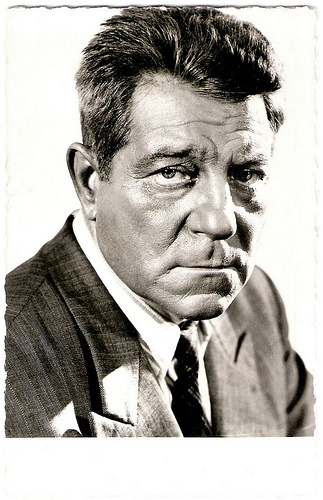
French postcard by Editions P.I., Paris, no. 1094. Offered by Les Carbones Korès 'Carboplane'. Photo: Marcel Bougureau.

Dutch postcard by Gebr. Spanjersberg N.V., Rotterdam, Dutch licence holder for Universum-Film Aktiengesellschaft, Berlin-Templehof, no. 1501. Photo: Serge Beauvarlet / Franco London Film, Paris. Publicity still for French Cancan (Jean Renoir, 1954) with Maria Félix .

Dutch postcard by Gebr. Spanjersberg N.V., Rotterdam, no. 2042. Photo: Pallas Film. Publicity still for Chiens perdus sans collier/The Little Rebels (Jean Delannoy, 1955).
Lemon Prize
Jean Gabin's career seemed headed for oblivion. In 1953 he was the male winner of the Lemon Prize, awarded by French journalists to the nastiest French actors. However, he made a comeback in the classic policier Touchez pas au grisbi/Don't Touch the Loot (Jacques Becker, 1954) with René Dary . His performance earned him critical acclaim, and the film was a very profitable international success.
Later, he worked once again with Jean Renoir on French Cancan (1955), with María Félix and Françoise Arnoul . Over the next twenty years, Gabin made close to 50 more films, most of them very successful commercially and critically, including many for Gafer Films, his production partnership with fellow actor Fernandel .
One of his most popular personalities was inspector Maigret from the detective novels by Georges Simenon in Maigret tend un piège/Maigret Sets a Trap (Jean Delannoy, 1958) and Maigret et l'affaire Saint-Fiacre/Maigret and the St. Fiacre Case (Jean Delannoy, 1959). But he was also able to play all other kind of people: aristocrats, farmers, thieves and managers.
With age, a new Gabin persona emerged, more solid, more self-assured, yet always human. His co-stars included French cinema stars as his good friend Lino Ventura in Razzia sur la Chnouf/Razzia (Henri Decoin, 1955), Bourvil in La traversée de Paris/The Trip Across Paris (Claude Autant-Lara, 1956), Brigitte Bardot in En cas de malheur/In Case of Adversity (Claude Autant-Lara, 1958), Jean-Paul Belmondo in Un singe en hiver/A Monkey in Winter (Henri Verneuil, 1962), Simone Signoret in Le Chat/The Cat (Pierre Granier-Deferre, 1971), and Alain Delon in Mélodie en sous-sol/Any Number Can Win (Henri Verneuil, 1963), Le Clan des Siciliens/The Sicilian Clan (Henri Verneuil, 1969), and Deux hommes dans la ville/Two Men in Town (José Giovanni, 1973).
In 1960 Gabin was made an Officier de la Légion d'honneur (officer of France's Legion of Honor). Gabin never stopped working and when death surprised him in 1976 he was still an institution for the French audience. His last film was the comedy L'Année sainte/Holy Year (Jean Girault, 1976).
Jean Gabin died in 1976 of a heart attack in the Parisian suburb of Neuilly-sur-Seine. His body was cremated and with full military honours, his ashes were dispersed into the sea from the military ship Détroyat.
Since 1949, he had been married to Dominique Fournier, who had been a mannequin for couturier Lanvin. They had three children, Valérie Moncorgé, Florence Moncorgé and Mathias Moncorgé. He had bought a sprawling farm in Normandy, and was as contented in his life as the country farmer as he was acting in front of a film camera. The Musée Jean Gabin in his native town, Mériel, contains his story and features his war and film memorabilia.
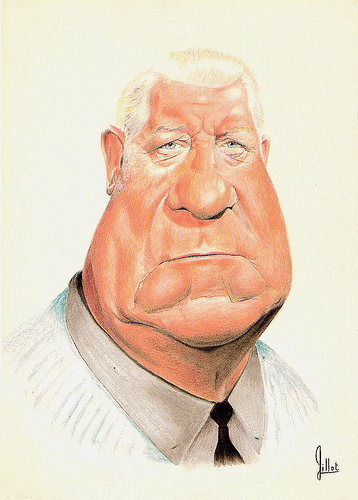
French postcard by Editions et Impressions Combier, Mâcon, no. 3. Illustration: Jean-Pierre Gillot.
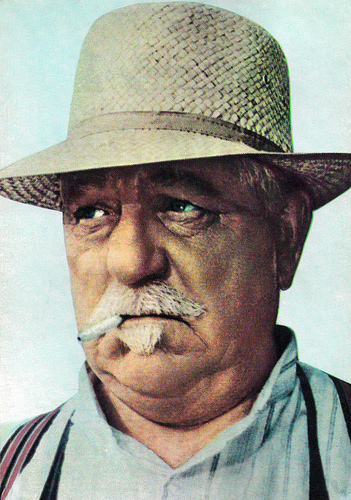
Romanian postcard by Casa Filmului Acin. Photo: publicity still for Le jardinier d'Argenteuil/The Gardener of Argenteuil (Jean-Paul Le Chanois, 1966).

French postcard by Editions Hazan, Paris, 1991, no. 6251. Photo: publicity still for Le cave se rebiffe/Money Money Money (Gilles Grangier, 1961) with Bernard Blier .

Czech collectors card by Pressfoto, Praha (Prague), no. S 125/6, 1966. Publicity still for Un Singe en Hiver/A Monkey in Winter (Henri Verneuil, 1962) with Jean-Paul Belmondo .
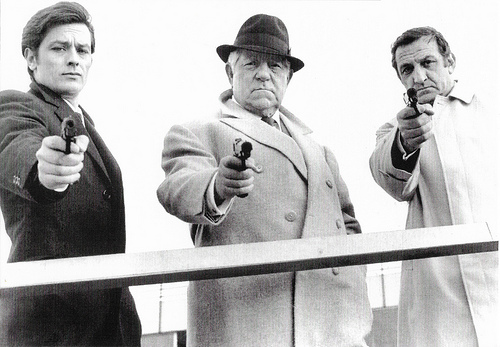
French postcard by Finart-Print (DR), no. 304. Photo: publicity still for Le clan des Siciliens/The Sicilian Clan (Henri Verneuil, 1969) with Alain Delon , Jean Gabin and Lino Ventura .
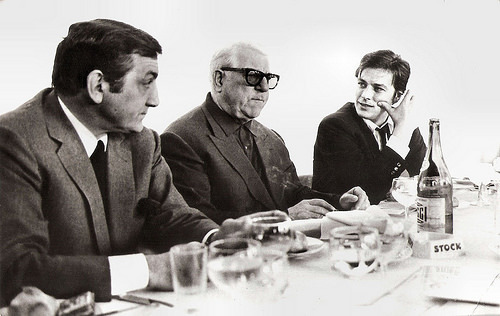
Romanian postcard by Cas Filmului Acin, no. 436. Photo: publicity still for Le clan des Siciliens/The Sicilian Clan (Henri Verneuil, 1969) with Lino Ventura and Alain Delon .

East-German postcard by VEB Progress Film-Vertrieb, no. 152/72. Photo: Unifrance Film. Publicity still for Le soleil des voyous/Leather and Nylon (Jean Delannoy, 1967).
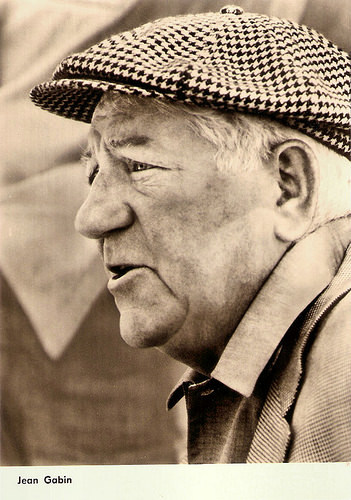
East-German postcard by VEB Progress Film-Vertrieb, no. 2917, 1967. Photo: Unifrance Film. Publicity still for Le soleil des voyous/Leather and Nylon (Jean Delannoy, 1967).
Trailer La grande Illusion/The Grand Illusion (1937). Source: Danios 12345 (YouTube).
Trailer for French Cancan (1955). Source: BFI Trailers (YouTube).
Trailer En Cas de Malheur (1958). Source: films7story (YouTube).
Trailer Le clan des Siciliens/The Sicilian Clan (1969). Source: Dicfish (YouTube).
Sources: James Travers (Films de France), (IMDb), Wikipedia, and .

French postcard by Editions P.I., Paris, no. 23.

French postcard by Editions O.P., Paris, no. 29. Photo: Star. Publicity still for Gueule d'amour/Madeleine (Jean Grémillon, 1937).

French postcard by A.N., Paris, no. 1160. Photo: Films Osso. Publicity still for Le quai des brumes/Port of Shadows (Marcel Carne, 1938).

French postcard by Edit. Chantal, Rueil (S.-O.), no, 49B. Photo: Raymond Voinquel / Sigma. Publicity still for Le jour se lève/Daybreak (Marcel Carne, 1939).

French postcard by Edition Chantal, Paris, no. 49.

French collectors card by Massilia.
From Bottom To Top
Jean Gabin was born Jean-Alexis Gabin Moncorgé in Paris, in 1904. He grew up in the village of Mériel in the Seine-et-Oise département, about 35 km north of Paris. His parents, Ferdinand Moncorgé and Hélène Petit, were entertainers, who performed in local cafés.
Jean worked as a labourer, but from an early age, entertainment was in his blood. At 18, he took a turn at the Folies-Bergère. He then appeared in revues and operettas, singing and dancing, and becoming famous for his imitation of Maurice Chevalier .
Through a chance meeting with the singer Mistinguett in 1928, he was given a spot at the Moulin-Rouge. This led to uncredited parts in two silent sketch films Ohé! Les valises/Hey! Suitcases (1928) and Les Lions/The Lions (1928) with the comic Raymond Dandy.
Two years later, he easily made the transition to sound film in the Pathé Frères production Chacun sa Chance/Everyone a chance (René Pujol, Hans Steinhoff, 1930). In this film he appeared with Gaby Basset, whom he had married in 1927.
Gabin made more than a dozen films over the next four years, including Méphisto (Henri Debain, Georges Vinter, 1930), Tout ça ne vaut pas l'amour/While it's not worth the love (Jacques Tourneur, 1931), Coeur de lilas/Lilac (Anatole Litvak, 1932), Les gaietés de l'escadron/Fun in Barracks (Maurice Tourneur, 1932), La Foule hurle (John Daumery, Howard Hawks, 1932) and Du haut en bas/From Top to Bottom (Georg Wilhelm Pabst, 1933).
He gained real recognition for his performance in Maria Chapdelaine (Julien Duvivier, 1934) starring Madeleine Renaud . Cast as a romantic hero opposite Annabella in the war drama La Bandera/Escape from Yesterday (Julien Duvivier, 1936) established Gabin as a major star.
He teamed up with Julien Duvivier again, this time in La belle équipe/They Were Five (1936) and in the highly successful Pépé le Moko (1937) that became one of the top grossing films of 1937 worldwide. Its popularity brought Gabin international recognition.
That same year, he starred in the masterpiece La grande Illusion/The Grand Illusion (Jean Renoir, 1937) an anti-war film that was a huge box office success and given universal critical acclaim, even running at a New York City theatre for an unprecedented six months.
This was followed by another one of Renoir's great successes: La bête humaine/The Human Beast (Jean Renoir, 1938), a Film Noir tragedy based on the novel by Émile Zola and starring Gabin and Simone Simon , as well as Le quai des brumes/Port of Shadows (1938) and Le jour se lève/Daybreak (1939) with Arletty , two of director Marcel Carné's most acclaimed films.

French postcard by A.N., Paris, no. 692. Photo: Film Pathé-Natan. Publicity still for Chacun sa chance/Everyone a chance (René Pujol, Hans Steinhoff, 1930).

French postcard by Edition Chantal, Paris, no. 49. Photo: Pathé-Consortium.

French postcard, no. 49. Photo: publicity still for La Bandera (Julien Duvivier, 1935).

French postcard by Erpé, no. 567. Photo: Film ACE, Paris. Publicity still for Gueule d'amour/Madeleine (Jean Grémillon, 1937).

French postcard by Crépa, Editeur, Paris. Photo: Sam Lévin. Publicity still for La grande illusion/The Grand Illusion (Jean Renoir, 1937) with Jean Gabin, Dalio , Julien Carette, Gaston Modot and Pierre Fresnay .

French postcard by Crépa, Editeur, Paris. Photo: Sam Lévin / Production R.A.C. Marcel Dalio , Gaston Modot and Jean Gabin in La grande illusion/The Grand Illusion (Jean Renoir, 1937).

French postcard by Edit. Chantal, Rueil, no. 49B.

French postcard by Viny, no. 12. Photo: Paris Film.

French postcard by edition Chantal, Paris, no. 49A. Photo: Paris Film Production.
Marlene
Jean Gabin was flooded with offers from Hollywood. For a time he turned them all down until the outbreak of World War II. Following the German occupation of France, he joined Jean Renoir and Julien Duvivier in the United States.
He had divorced his second wife Suzanne Mauchain in 1939, and during his time in Hollywood, Gabin began a torrid romance with film star Marlene Dietrich .
His Hollywood film career proved to be less successful: he made two films, Moon Tide (Archie Mayo, 1942) and The Impostor (Julien Duvivier, 1944), both of which were flops. Scheduled to star in an RKO film, at the last minute he demanded Dietrich be given the co-starring role. The studio refused. After Gabin remained steadfast in his demand, he was fired, and the film project was shelved.
Undaunted, he enlisted in 1943 as a tank commander in the Forces françaises libres. He earned the Médaille Militaire and a Croix de Guerre for his wartime valour fighting with the Allies in North Africa. Following D-Day, Gabin was part of the military contingent that entered a liberated Paris. Captured on film by the media is a scene where an anxious Marlene Dietrich is waiting in the crowd when she spots Gabin onboard a battle tank and rushes to him.
In 1946, Gabin was hired by Marcel Carné to star in the film, Les Portes de la Nuit/Gates of the Night, but his conduct got him fired again. He then found a French producer and director willing to cast him and Marlene Dietrich together in the box office success Martin Roumagnac/The Room Upstairs (Georges Lacombe, 1946), but their personal relationship soon ended.
After the box office failure of Miroir/Mirror (Raymond Lamy, 1947) Gabin returned to the stage, but there too, the production was a financial disaster. He was cast in the lead role of Au-Delà Des Grilles/The Walls of Malapaga (René Clément, 1949) that won the Academy Award for Best Foreign Language Film. Despite this recognition, the film did not do well at the French box office, and the next five years brought little more than repeated box office failures.

French postcard by S.E.R.P., Paris, no. 135. Photo: Studio Harcourt.

French postcard by S.E.R.P., Paris, no. 22. Photo: Studio Harcourt.

French postcard by Editions P.I., Paris, no. 1094. Offered by Les Carbones Korès 'Carboplane'. Photo: Marcel Bougureau.

Dutch postcard by Gebr. Spanjersberg N.V., Rotterdam, Dutch licence holder for Universum-Film Aktiengesellschaft, Berlin-Templehof, no. 1501. Photo: Serge Beauvarlet / Franco London Film, Paris. Publicity still for French Cancan (Jean Renoir, 1954) with Maria Félix .

Dutch postcard by Gebr. Spanjersberg N.V., Rotterdam, no. 2042. Photo: Pallas Film. Publicity still for Chiens perdus sans collier/The Little Rebels (Jean Delannoy, 1955).
Lemon Prize
Jean Gabin's career seemed headed for oblivion. In 1953 he was the male winner of the Lemon Prize, awarded by French journalists to the nastiest French actors. However, he made a comeback in the classic policier Touchez pas au grisbi/Don't Touch the Loot (Jacques Becker, 1954) with René Dary . His performance earned him critical acclaim, and the film was a very profitable international success.
Later, he worked once again with Jean Renoir on French Cancan (1955), with María Félix and Françoise Arnoul . Over the next twenty years, Gabin made close to 50 more films, most of them very successful commercially and critically, including many for Gafer Films, his production partnership with fellow actor Fernandel .
One of his most popular personalities was inspector Maigret from the detective novels by Georges Simenon in Maigret tend un piège/Maigret Sets a Trap (Jean Delannoy, 1958) and Maigret et l'affaire Saint-Fiacre/Maigret and the St. Fiacre Case (Jean Delannoy, 1959). But he was also able to play all other kind of people: aristocrats, farmers, thieves and managers.
With age, a new Gabin persona emerged, more solid, more self-assured, yet always human. His co-stars included French cinema stars as his good friend Lino Ventura in Razzia sur la Chnouf/Razzia (Henri Decoin, 1955), Bourvil in La traversée de Paris/The Trip Across Paris (Claude Autant-Lara, 1956), Brigitte Bardot in En cas de malheur/In Case of Adversity (Claude Autant-Lara, 1958), Jean-Paul Belmondo in Un singe en hiver/A Monkey in Winter (Henri Verneuil, 1962), Simone Signoret in Le Chat/The Cat (Pierre Granier-Deferre, 1971), and Alain Delon in Mélodie en sous-sol/Any Number Can Win (Henri Verneuil, 1963), Le Clan des Siciliens/The Sicilian Clan (Henri Verneuil, 1969), and Deux hommes dans la ville/Two Men in Town (José Giovanni, 1973).
In 1960 Gabin was made an Officier de la Légion d'honneur (officer of France's Legion of Honor). Gabin never stopped working and when death surprised him in 1976 he was still an institution for the French audience. His last film was the comedy L'Année sainte/Holy Year (Jean Girault, 1976).
Jean Gabin died in 1976 of a heart attack in the Parisian suburb of Neuilly-sur-Seine. His body was cremated and with full military honours, his ashes were dispersed into the sea from the military ship Détroyat.
Since 1949, he had been married to Dominique Fournier, who had been a mannequin for couturier Lanvin. They had three children, Valérie Moncorgé, Florence Moncorgé and Mathias Moncorgé. He had bought a sprawling farm in Normandy, and was as contented in his life as the country farmer as he was acting in front of a film camera. The Musée Jean Gabin in his native town, Mériel, contains his story and features his war and film memorabilia.

French postcard by Editions et Impressions Combier, Mâcon, no. 3. Illustration: Jean-Pierre Gillot.

Romanian postcard by Casa Filmului Acin. Photo: publicity still for Le jardinier d'Argenteuil/The Gardener of Argenteuil (Jean-Paul Le Chanois, 1966).

French postcard by Editions Hazan, Paris, 1991, no. 6251. Photo: publicity still for Le cave se rebiffe/Money Money Money (Gilles Grangier, 1961) with Bernard Blier .

Czech collectors card by Pressfoto, Praha (Prague), no. S 125/6, 1966. Publicity still for Un Singe en Hiver/A Monkey in Winter (Henri Verneuil, 1962) with Jean-Paul Belmondo .

French postcard by Finart-Print (DR), no. 304. Photo: publicity still for Le clan des Siciliens/The Sicilian Clan (Henri Verneuil, 1969) with Alain Delon , Jean Gabin and Lino Ventura .

Romanian postcard by Cas Filmului Acin, no. 436. Photo: publicity still for Le clan des Siciliens/The Sicilian Clan (Henri Verneuil, 1969) with Lino Ventura and Alain Delon .

East-German postcard by VEB Progress Film-Vertrieb, no. 152/72. Photo: Unifrance Film. Publicity still for Le soleil des voyous/Leather and Nylon (Jean Delannoy, 1967).

East-German postcard by VEB Progress Film-Vertrieb, no. 2917, 1967. Photo: Unifrance Film. Publicity still for Le soleil des voyous/Leather and Nylon (Jean Delannoy, 1967).
Trailer La grande Illusion/The Grand Illusion (1937). Source: Danios 12345 (YouTube).
Trailer for French Cancan (1955). Source: BFI Trailers (YouTube).
Trailer En Cas de Malheur (1958). Source: films7story (YouTube).
Trailer Le clan des Siciliens/The Sicilian Clan (1969). Source: Dicfish (YouTube).
Sources: James Travers (Films de France), (IMDb), Wikipedia, and .
Published on June 22, 2019 22:00
June 21, 2019
One hundred years ago: 1919
Ciao! We're in Bologna, Italy. Like every year, we join here the Cinema Ritrovato festival: one of the greatest film parties in the world, offering some 500 great films, masterpieces and rarities. EFSP follows the events with posts on actors and programs. We start with 'One hundred years ago: 1919', for which Ivo Blom made a selection with rare postcards with stars from the films which are shown in this section.
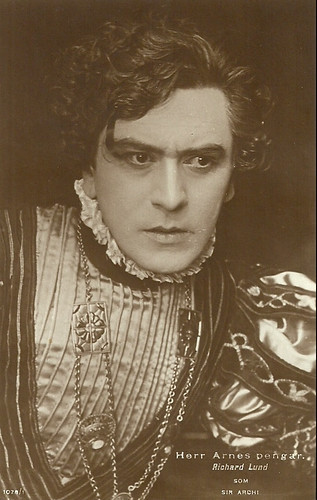
Swedish postcard by Förlag Nordisk Konst, Stockholm, no 1078/1. Richard Lund as Sir Archi(e) in Herr Arnes pengar/Sir Arne's Treasure (Mauritz Stiller, 1919).
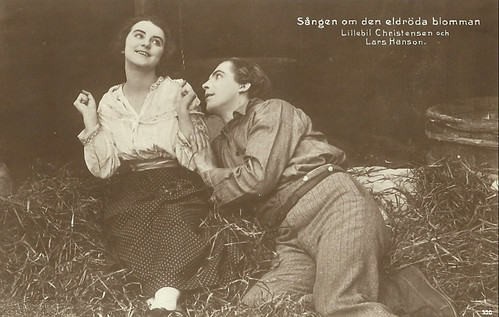
Swedish postcard by Nordisk Konst, no. 550. Photo: Svenska Biografteatern, Stockholm. Lars Hanson and Lillebil Christensen in Sängen om den eldröda blomman/The Song of the Red Flower (Mauritz Stiller, 1919).
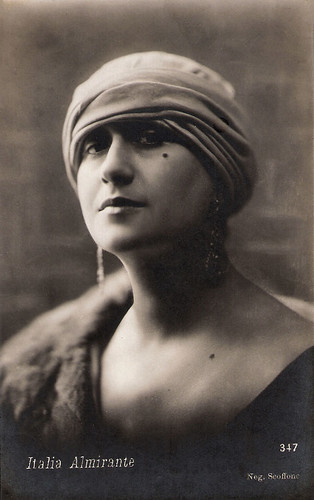
Italia Almirante . Italian postcard by Neg. Scofione, no. 347.
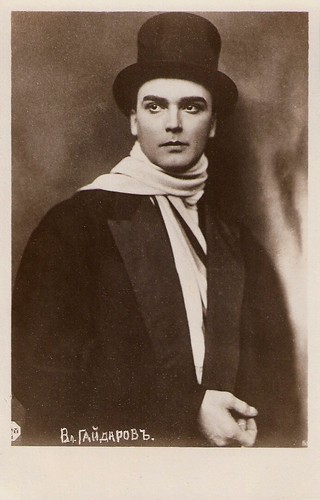
Vladimir Gajdarov . Latvian (?) postcard by KLTD. Photo: May-Film.
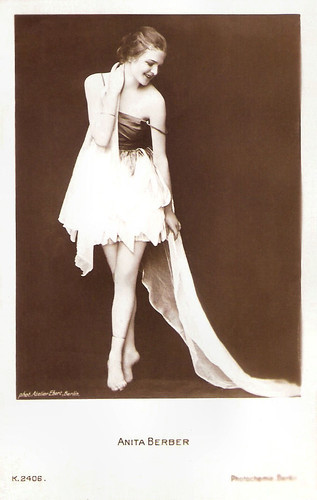
Anita Berber . German postcard by Photochemie, Berlin, no. K. 2406. Photo: Atelier Eberth, Berlin.
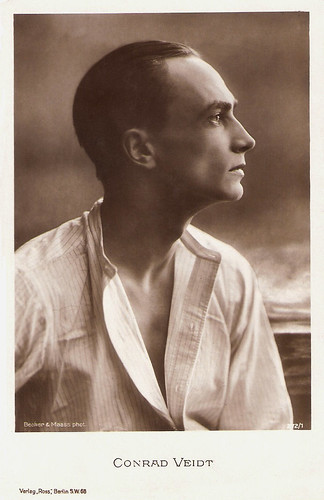
Conrad Veidt . German postcard by Ross Verlag, no. 272/1, 1919-1924. Photo: Becker & Maass, Berlin.
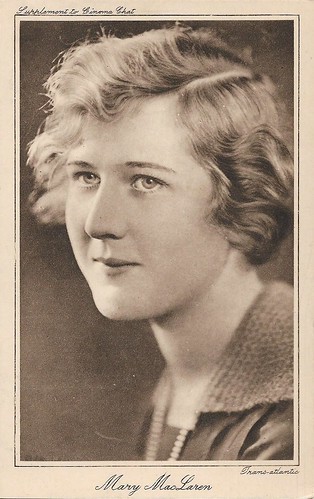
Mary MacLaren. British postcard in the Cinema Chat series. Photo: Transatlantic (Universal's European distribution branch).
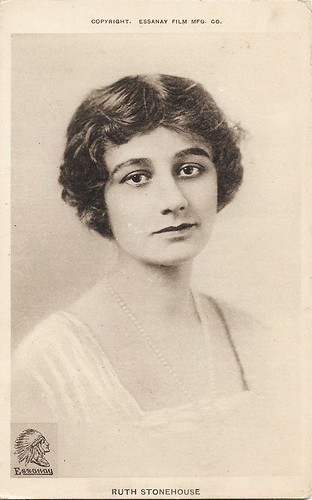
Ruth Stonehouse. British postcard. Photo: Essanay Film Manufacturing Company.
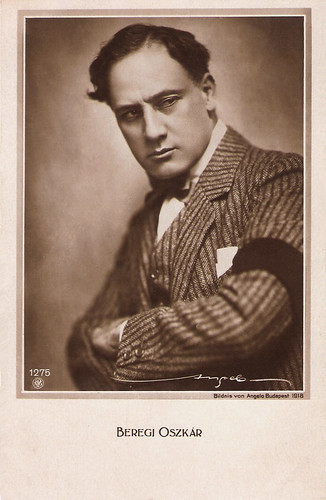
Oscar Beregi Sr. German postcard by NPG, no. 1275 Photo: Angelo, Budapest, 1918.
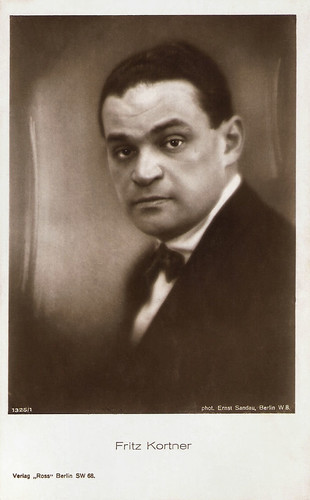
Fritz Kortner . German postcard by Ross Verlag, no. 1325/1, 1927-1928. Photo: Ernst Sandau, Berlin.
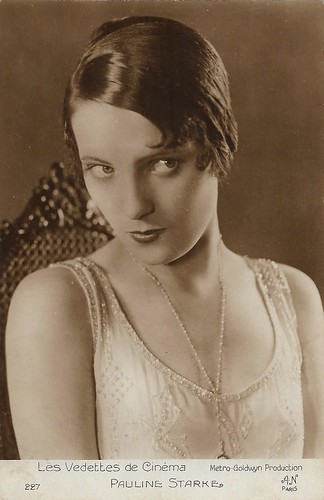
Pauline Starke. French postcard by Les Vedettes de Cinéma by A.N., Paris, no. 227. Photo: Metro-Goldwyn Production.

Swedish postcard by Förlag Nordisk Konst, Stockholm, no 1078/1. Richard Lund as Sir Archi(e) in Herr Arnes pengar/Sir Arne's Treasure (Mauritz Stiller, 1919).

Swedish postcard by Nordisk Konst, no. 550. Photo: Svenska Biografteatern, Stockholm. Lars Hanson and Lillebil Christensen in Sängen om den eldröda blomman/The Song of the Red Flower (Mauritz Stiller, 1919).

Italia Almirante . Italian postcard by Neg. Scofione, no. 347.

Vladimir Gajdarov . Latvian (?) postcard by KLTD. Photo: May-Film.

Anita Berber . German postcard by Photochemie, Berlin, no. K. 2406. Photo: Atelier Eberth, Berlin.

Conrad Veidt . German postcard by Ross Verlag, no. 272/1, 1919-1924. Photo: Becker & Maass, Berlin.

Mary MacLaren. British postcard in the Cinema Chat series. Photo: Transatlantic (Universal's European distribution branch).

Ruth Stonehouse. British postcard. Photo: Essanay Film Manufacturing Company.

Oscar Beregi Sr. German postcard by NPG, no. 1275 Photo: Angelo, Budapest, 1918.

Fritz Kortner . German postcard by Ross Verlag, no. 1325/1, 1927-1928. Photo: Ernst Sandau, Berlin.

Pauline Starke. French postcard by Les Vedettes de Cinéma by A.N., Paris, no. 227. Photo: Metro-Goldwyn Production.
Published on June 21, 2019 22:00
June 20, 2019
The Sword in the Stone (1963)
The 18th Disney animated feature film, The Sword in the Stone (Wolfgang Reitherman, 1963) is a take on King Arthur's legend, scripted by Bill Peet. It was the final Animation feature to be released before Walt Disney's death and the first solo directorial effort of famous animator Wolfgang Reithermann.
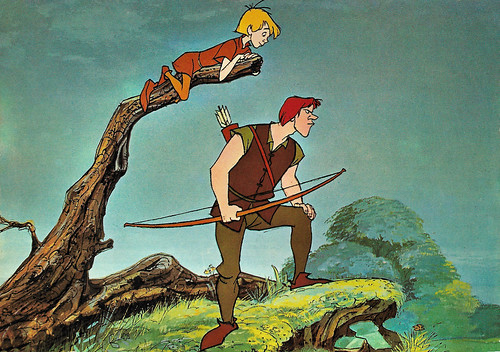
Italian postcard by Grafiche Biondetti S.R.L., Verona, no. 116. Image: Disney. Publicity still for The Sword in the Stone (Wolfgang Reitherman, 1963).

Italian postcard by Grafiche Biondetti, Verona, no. 116. Image: Walt Disney Productions. Publicity still for The Sword in the Stone (Wolfgang Reitherman, 1963).

French postcard by Walt Disney Productions, 1964. Image: Disney. Publicity still for The Sword in the Stone (Wolfgang Reitherman, 1963) in French: Merlin l'enchanteur.
A screamingly funny bit of nonsense
The Sword in the Stone (Wolfgang Reitherman, 1963) is based on the novel by T.H. White, which was first published in 1938, and was republished in 1958 as the first book of the tetralogy 'The Once and Future King'. In 1939, Walt Disney first obtained the film rights to White's novel, and the initial storyboards were produced in 1949. When work on One Hundred and One Dalmatians was completed in 1960, The Sword in the Stone was in development by veteran story artist Bill Peet.
After Disney had seen the 1960 Broadway production of 'Camelot', he approved the project to enter production. The Sword in the Stone, was released to theatres on 25 December 1963 to mixed reviews. The songs in the film were written and composed by the Sherman Brothers.
The King of England dies, and no heir to the throne is named, leaving England threatened to be torn apart by war. Miraculously, the 'Sword in the Stone' appears inside an anvil in London, with an inscription proclaiming that whoever can pull it out is the rightful King of England. Many try to remove the sword, but none succeed, and the sword is eventually forgotten, leaving England in the Dark Ages.
Years later, a 12-year-old orphan named Arthur, commonly called Wart, meets Merlin the wizard, and his talking pet owl Archimedes. Merlin declares himself Arthur's tutor. Sir Pellinore announces that the annual jousting tournament will be held in London, and the winner will be crowned king. Sir Ector, Arthur's foster father, decides to put his son, Kay through serious training for the tournament and appoints Arthur as Kay's squire.
Bosley Crowther of The New York Times praised the film: "Adapting T. H. White's beloved novel of King Arthur's boyhood, the Disney unit has shaped a warm, wise and amusing film version. The unorthodox source, with its artful earthiness, was certainly no snap undertaking as a movie cartoon. To the credit of the scenarist, Bill Peet, the director, Wolfgang Reitherman, and their colleagues, the picture makes an eye-filling package of rollicking fun and thoughtful common sense. The humor sparkles with real, knowing sophistication."
"Just as flavorsome, visually, are several droll caricatures of English nobility, a temperamental, educated owl named Archimedes and, for good measure, a perky, self-spooning little sugar bowl. But the most beguiling of the lot is Merlin's arch rival, a harum-scarum old sorceress named Madam Mim. Their 'magicians' duel', a screamingly funny bit of nonsense, is pure Disney gold. This sequence alone should be enough Christmas for anybody."
Aubry Anne D'Arminio at AllMovie : "The lackluster animation and unimpressive musical numbers disappointed audiences upon the film's initial opening, but its tale of a stout-hearted child destined for greatness proved timeless as it lured scores of Disney fans to theaters upon its several re-releases."
"If the movie's animation is not up to par, the remarkable and eccentric characters well make up for it. The skinny, bowlegged Wart is as much a hero as his predecessors, the wooden Pinocchio and the big-eared Dumbo. Moreover, Merlin's skeptical sidekick, the scholarly owl Archimedes, as well as his wacky nemesis, the sorceress Mad Madam Mim , make the film as colorful as any of its state-of-the-art cartoon counterparts."
The Sword in the Stone was a box office success and became the sixth highest-grossing film of 1963. A live-action adaptation of the film directed by Juan Carlos Fresnadillo is scheduled to be released later in 2019.
This was the last post in our Walt Disney week, but more posts on Disney Classics will follow soon.

French postcard by Les Presses de Belleville, Paris, no. 347. Image: Walt Disney, 1964. Publicity still for The Sword in the Stone (Wolfgang Reitherman, 1963). Caption: A little squirrel girl came to say hello.
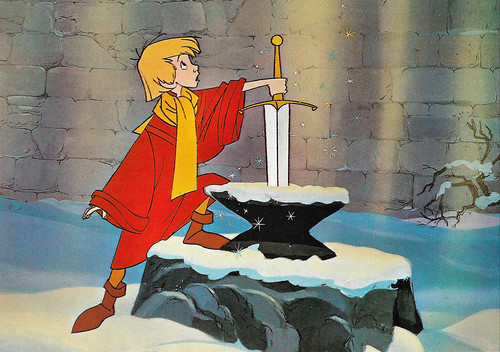
Italian postcard by Grafiche Biondetti S.R.L., Verona, no. 116/1. Image: Disney. Publicity still for The Sword in the Stone (Wolfgang Reitherman, 1963).
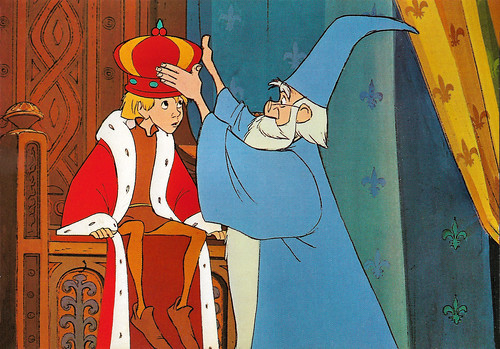
Italian postcard by Grafiche Biondetti S.R.L., Verona. Image: Disney. Publicity still for The Sword in the Stone (Wolfgang Reitherman, 1963). Sent by mail in 1998.
Sources: Bosley Crowther (The New York Times), Aubry Anne D'Arminio (AllMovie), Wikipedia and IMDb.

Italian postcard by Grafiche Biondetti S.R.L., Verona, no. 116. Image: Disney. Publicity still for The Sword in the Stone (Wolfgang Reitherman, 1963).

Italian postcard by Grafiche Biondetti, Verona, no. 116. Image: Walt Disney Productions. Publicity still for The Sword in the Stone (Wolfgang Reitherman, 1963).

French postcard by Walt Disney Productions, 1964. Image: Disney. Publicity still for The Sword in the Stone (Wolfgang Reitherman, 1963) in French: Merlin l'enchanteur.
A screamingly funny bit of nonsense
The Sword in the Stone (Wolfgang Reitherman, 1963) is based on the novel by T.H. White, which was first published in 1938, and was republished in 1958 as the first book of the tetralogy 'The Once and Future King'. In 1939, Walt Disney first obtained the film rights to White's novel, and the initial storyboards were produced in 1949. When work on One Hundred and One Dalmatians was completed in 1960, The Sword in the Stone was in development by veteran story artist Bill Peet.
After Disney had seen the 1960 Broadway production of 'Camelot', he approved the project to enter production. The Sword in the Stone, was released to theatres on 25 December 1963 to mixed reviews. The songs in the film were written and composed by the Sherman Brothers.
The King of England dies, and no heir to the throne is named, leaving England threatened to be torn apart by war. Miraculously, the 'Sword in the Stone' appears inside an anvil in London, with an inscription proclaiming that whoever can pull it out is the rightful King of England. Many try to remove the sword, but none succeed, and the sword is eventually forgotten, leaving England in the Dark Ages.
Years later, a 12-year-old orphan named Arthur, commonly called Wart, meets Merlin the wizard, and his talking pet owl Archimedes. Merlin declares himself Arthur's tutor. Sir Pellinore announces that the annual jousting tournament will be held in London, and the winner will be crowned king. Sir Ector, Arthur's foster father, decides to put his son, Kay through serious training for the tournament and appoints Arthur as Kay's squire.
Bosley Crowther of The New York Times praised the film: "Adapting T. H. White's beloved novel of King Arthur's boyhood, the Disney unit has shaped a warm, wise and amusing film version. The unorthodox source, with its artful earthiness, was certainly no snap undertaking as a movie cartoon. To the credit of the scenarist, Bill Peet, the director, Wolfgang Reitherman, and their colleagues, the picture makes an eye-filling package of rollicking fun and thoughtful common sense. The humor sparkles with real, knowing sophistication."
"Just as flavorsome, visually, are several droll caricatures of English nobility, a temperamental, educated owl named Archimedes and, for good measure, a perky, self-spooning little sugar bowl. But the most beguiling of the lot is Merlin's arch rival, a harum-scarum old sorceress named Madam Mim. Their 'magicians' duel', a screamingly funny bit of nonsense, is pure Disney gold. This sequence alone should be enough Christmas for anybody."
Aubry Anne D'Arminio at AllMovie : "The lackluster animation and unimpressive musical numbers disappointed audiences upon the film's initial opening, but its tale of a stout-hearted child destined for greatness proved timeless as it lured scores of Disney fans to theaters upon its several re-releases."
"If the movie's animation is not up to par, the remarkable and eccentric characters well make up for it. The skinny, bowlegged Wart is as much a hero as his predecessors, the wooden Pinocchio and the big-eared Dumbo. Moreover, Merlin's skeptical sidekick, the scholarly owl Archimedes, as well as his wacky nemesis, the sorceress Mad Madam Mim , make the film as colorful as any of its state-of-the-art cartoon counterparts."
The Sword in the Stone was a box office success and became the sixth highest-grossing film of 1963. A live-action adaptation of the film directed by Juan Carlos Fresnadillo is scheduled to be released later in 2019.
This was the last post in our Walt Disney week, but more posts on Disney Classics will follow soon.

French postcard by Les Presses de Belleville, Paris, no. 347. Image: Walt Disney, 1964. Publicity still for The Sword in the Stone (Wolfgang Reitherman, 1963). Caption: A little squirrel girl came to say hello.

Italian postcard by Grafiche Biondetti S.R.L., Verona, no. 116/1. Image: Disney. Publicity still for The Sword in the Stone (Wolfgang Reitherman, 1963).

Italian postcard by Grafiche Biondetti S.R.L., Verona. Image: Disney. Publicity still for The Sword in the Stone (Wolfgang Reitherman, 1963). Sent by mail in 1998.
Sources: Bosley Crowther (The New York Times), Aubry Anne D'Arminio (AllMovie), Wikipedia and IMDb.
Published on June 20, 2019 22:00
June 19, 2019
One Hundred and One Dalmatians (1961)
One Hundred and One Dalmatians (Clyde Geronimi, Hamilton Luske, 1961), often abbreviated as 101 Dalmatians, is an American animated adventure film based on the 1956 novel 'The Hundred and One Dalmatians' by Dodie Smith. It's the 17th Disney animated feature film.

Italian postcard by Grafiche Biondetti S.R.L., Verona. Illustration: Disney. Publicity still for One Hundred and One Dalmatians (Clyde Geronimi, Hamilton Luske, 1961).
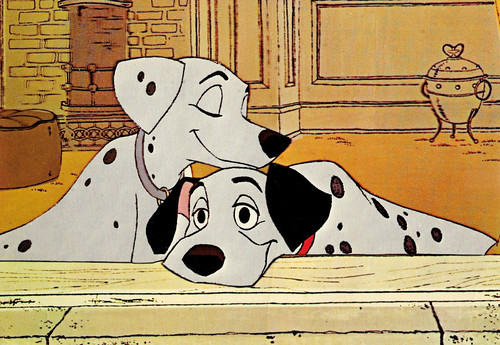
Italian postcard by JC, no. 3318. Image: Walt Disney Productions. Publicity still for One Hundred and One Dalmatians (Clyde Geronimi, Hamilton Luske, 1961).
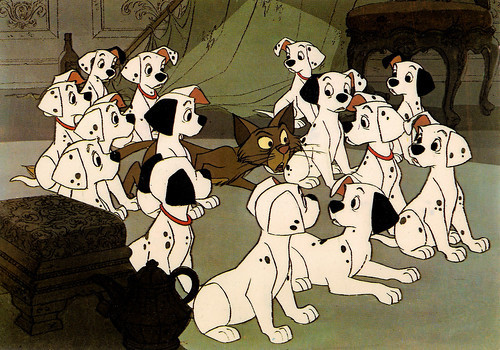
French postcard by Editions Kroma, Caissargues, no. B. 75. Image: Walt Disney Productions. Publicity still for One Hundred and One Dalmatians (Clyde Geronimi, Hamilton Luske, 1961).

French postcard by Kroma, Caissargues, no. B. 86. Publicity still for One Hundred and One Dalmatians (Clyde Geronimi, Hamilton Luske, 1961).

French postcard in the 'Le Monde Merveilleux de Walt Disney' by Editions Kroma, Caissargues, no. 97. Illustration: Walt Disney Productions. Publicity still for One Hundred and One Dalmatians (Clyde Geronimi, Hamilton Luske, 1961).
When Walt Disney read it, it immediately grabbed his attention
Dodie Smith wrote the book 'The Hundred and One Dalmatians' in 1956. When Walt Disney read it in 1957, it immediately grabbed his attention, and he promptly obtained the rights. Smith had always secretly hoped that Disney would make it into a film.
The 17th Disney animated feature film tells the story of a litter of Dalmatian puppies who are kidnapped by the villainous Cruella de Vil, who wants to use their fur to make into coats.
Their parents, Pongo and Perdita, set out to save their children from Cruella, all the while rescuing 84 additional puppies that were bought in pet shops, bringing the total of Dalmatians to 101.
Originally released to theatres on 25 January 1961, by Buena Vista Distribution, One Hundred and One Dalmatians (Clyde Geronimi, Hamilton Luske, 1961) was a box office success, pulling the studio out of the financial slump caused by Sleeping Beauty, a costlier production released two years prior.
Aside from its box office revenue, its commercial success was due to the employment of inexpensive animation techniques — such as using xerography during the process of inking and painting traditional animation cells — that kept production costs down.

Italian postcard by Grafiche Biondetti, Verona, no. 110/1. Photo: Disney. Publicity still for One Hundred and One Dalmatians (Clyde Geronimi, Hamilton Luske, 1961).

French postcard by Les Presses de Belville, Paris, no. 221, 1964. Publicity still for One Hundred and One Dalmatians (Clyde Geronimi, Hamilton Luske, 1961). Caption: The evasion from Devil's Castle.
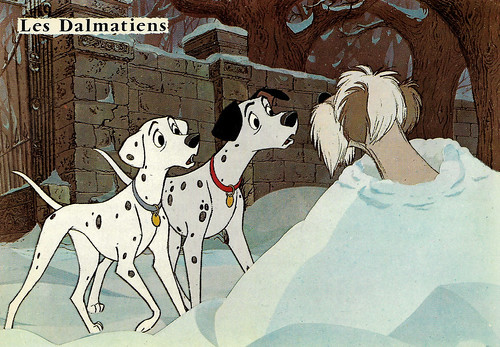
French postcard by Editions Krõma, Paris in the Le monde merveuilleux de Walt Disney series, no. B 83. Sent by mail in 1973. Illustration: Walt Disney Productions. Publicity still for One Hundred and One Dalmatians (Clyde Geronimi, Hamilton Luske, 1961).
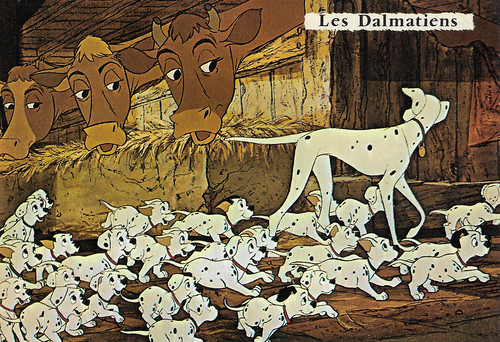
French postcard by Editions Krõma, Paris in the Le monde merveuilleux de Walt Disney series. Illustration: Walt Disney Productions. Publicity still for One Hundred and One Dalmatians (Clyde Geronimi, Hamilton Luske, 1961).
One of the greatest movie villains - cartoon or real - of all time
One Hundred and One Dalmatians was re-released theatrically in 1969, 1979, 1985, and 1991. The film's total domestic lifetime gross is $145 million, and its total worldwide gross is $215 million.
One Hundred and One Dalmatians was first released on VHS in 1992, as part of the Walt Disney Classics video series. Two months later, it had sold 11.1 million copies. At the time, it was the sixth best-selling video of all time.
In 1996, it was remade into a live-action film, 101 Dalmatians (Stephen Herek, 1996), starring Jeff Daniels, Joely Richardson and Glenn Close as Cruella de Vil. It grossed $136.2 million in North America and $320.7 million worldwide.
Disney has announced that another live-action film is in development, but this film will focus on the origin of Cruella de Vil. The prequel is titled Cruella and will be directed by Alex Timbers. Marc Platt and Andrew Gunn will produce. Glenn Close is executive producer. Emma Stone is set to play Cruella.
Hal Erickson at AllMovie : "101 Dalmatians represents the Disney animation staff at its very best, and as a bonus introduces the world to Cruella De Vil, one of the greatest movie villains - cartoon or "real" - of all time."

Spanish postcard by Ediciones Beascoa, S.A., Barcelona. Illustration: Disney. Publicity still for One Hundred and One Dalmatians (Clyde Geronimi, Hamilton Luske, 1961).
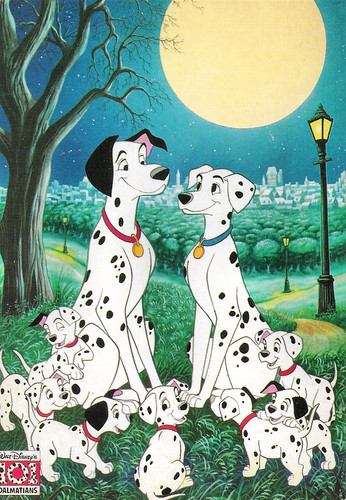
Italian postcard by Nuova Arti Grafiche Ricordi, Milano, no. 1603. Illustration: Disney. Publicity still for One Hundred and One Dalmatians (Clyde Geronimi, Hamilton Luske, 1961).
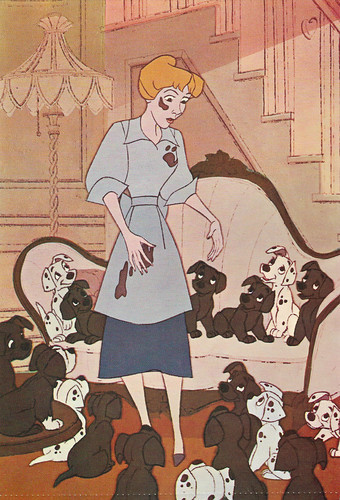
French postcard. Image: Walt Disney Productions. Publicity still for One Hundred and One Dalmatians (Clyde Geronimi, Hamilton Luske, 1961).

Russian postcard by Chromovogue, no. 850-4, 1998. Illustration: Disney. Publicity still for One Hundred and One Dalmatians (Clyde Geronimi, Hamilton Luske, 1961).
Sources: Hal Erickson (AllMovie), Wikipedia and IMDb.

Italian postcard by Grafiche Biondetti S.R.L., Verona. Illustration: Disney. Publicity still for One Hundred and One Dalmatians (Clyde Geronimi, Hamilton Luske, 1961).

Italian postcard by JC, no. 3318. Image: Walt Disney Productions. Publicity still for One Hundred and One Dalmatians (Clyde Geronimi, Hamilton Luske, 1961).

French postcard by Editions Kroma, Caissargues, no. B. 75. Image: Walt Disney Productions. Publicity still for One Hundred and One Dalmatians (Clyde Geronimi, Hamilton Luske, 1961).

French postcard by Kroma, Caissargues, no. B. 86. Publicity still for One Hundred and One Dalmatians (Clyde Geronimi, Hamilton Luske, 1961).

French postcard in the 'Le Monde Merveilleux de Walt Disney' by Editions Kroma, Caissargues, no. 97. Illustration: Walt Disney Productions. Publicity still for One Hundred and One Dalmatians (Clyde Geronimi, Hamilton Luske, 1961).
When Walt Disney read it, it immediately grabbed his attention
Dodie Smith wrote the book 'The Hundred and One Dalmatians' in 1956. When Walt Disney read it in 1957, it immediately grabbed his attention, and he promptly obtained the rights. Smith had always secretly hoped that Disney would make it into a film.
The 17th Disney animated feature film tells the story of a litter of Dalmatian puppies who are kidnapped by the villainous Cruella de Vil, who wants to use their fur to make into coats.
Their parents, Pongo and Perdita, set out to save their children from Cruella, all the while rescuing 84 additional puppies that were bought in pet shops, bringing the total of Dalmatians to 101.
Originally released to theatres on 25 January 1961, by Buena Vista Distribution, One Hundred and One Dalmatians (Clyde Geronimi, Hamilton Luske, 1961) was a box office success, pulling the studio out of the financial slump caused by Sleeping Beauty, a costlier production released two years prior.
Aside from its box office revenue, its commercial success was due to the employment of inexpensive animation techniques — such as using xerography during the process of inking and painting traditional animation cells — that kept production costs down.

Italian postcard by Grafiche Biondetti, Verona, no. 110/1. Photo: Disney. Publicity still for One Hundred and One Dalmatians (Clyde Geronimi, Hamilton Luske, 1961).

French postcard by Les Presses de Belville, Paris, no. 221, 1964. Publicity still for One Hundred and One Dalmatians (Clyde Geronimi, Hamilton Luske, 1961). Caption: The evasion from Devil's Castle.

French postcard by Editions Krõma, Paris in the Le monde merveuilleux de Walt Disney series, no. B 83. Sent by mail in 1973. Illustration: Walt Disney Productions. Publicity still for One Hundred and One Dalmatians (Clyde Geronimi, Hamilton Luske, 1961).

French postcard by Editions Krõma, Paris in the Le monde merveuilleux de Walt Disney series. Illustration: Walt Disney Productions. Publicity still for One Hundred and One Dalmatians (Clyde Geronimi, Hamilton Luske, 1961).
One of the greatest movie villains - cartoon or real - of all time
One Hundred and One Dalmatians was re-released theatrically in 1969, 1979, 1985, and 1991. The film's total domestic lifetime gross is $145 million, and its total worldwide gross is $215 million.
One Hundred and One Dalmatians was first released on VHS in 1992, as part of the Walt Disney Classics video series. Two months later, it had sold 11.1 million copies. At the time, it was the sixth best-selling video of all time.
In 1996, it was remade into a live-action film, 101 Dalmatians (Stephen Herek, 1996), starring Jeff Daniels, Joely Richardson and Glenn Close as Cruella de Vil. It grossed $136.2 million in North America and $320.7 million worldwide.
Disney has announced that another live-action film is in development, but this film will focus on the origin of Cruella de Vil. The prequel is titled Cruella and will be directed by Alex Timbers. Marc Platt and Andrew Gunn will produce. Glenn Close is executive producer. Emma Stone is set to play Cruella.
Hal Erickson at AllMovie : "101 Dalmatians represents the Disney animation staff at its very best, and as a bonus introduces the world to Cruella De Vil, one of the greatest movie villains - cartoon or "real" - of all time."

Spanish postcard by Ediciones Beascoa, S.A., Barcelona. Illustration: Disney. Publicity still for One Hundred and One Dalmatians (Clyde Geronimi, Hamilton Luske, 1961).

Italian postcard by Nuova Arti Grafiche Ricordi, Milano, no. 1603. Illustration: Disney. Publicity still for One Hundred and One Dalmatians (Clyde Geronimi, Hamilton Luske, 1961).

French postcard. Image: Walt Disney Productions. Publicity still for One Hundred and One Dalmatians (Clyde Geronimi, Hamilton Luske, 1961).

Russian postcard by Chromovogue, no. 850-4, 1998. Illustration: Disney. Publicity still for One Hundred and One Dalmatians (Clyde Geronimi, Hamilton Luske, 1961).
Sources: Hal Erickson (AllMovie), Wikipedia and IMDb.
Published on June 19, 2019 22:00
Paul van Yperen's Blog
- Paul van Yperen's profile
- 13 followers
Paul van Yperen isn't a Goodreads Author
(yet),
but they
do have a blog,
so here are some recent posts imported from
their feed.



